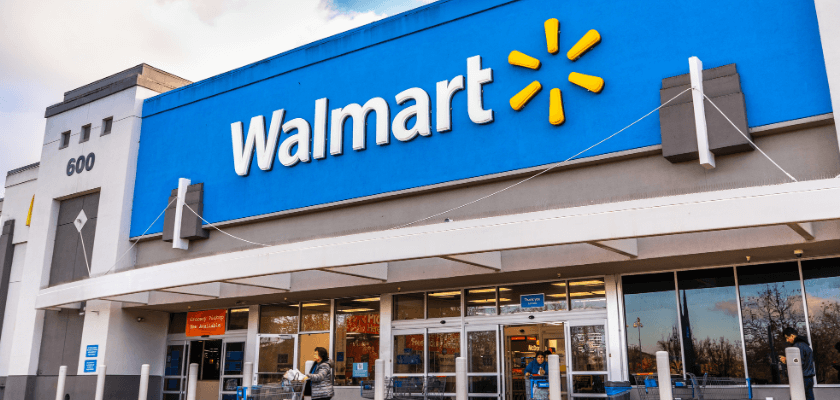

A Detailed Case Study on Largest Retail Giant Walmart

Avinash kumar mahato
Walmart is one of the largest retail companies in the world. It was founded in 1962 by Sam Walton. The headquarter of this company is situated in the United States. The main aim of the company is to provide consistent discounts, loyal customer service, and fast friendly service.
Walmart’s targets to expand its business in large cities as well as spread retail stores throughout the world. The retail stores of Walmart are divided into four divisions Walmart Supercenters , Discount Stores, Neighborhood Markets, and Sam’s Clubs warehouses. More than 100 million customers are visiting these Walmart Stores.
It is very uncomfortable for small merchants and communities in America. Walmart reaches their town and provides low-cost offers and the best customer service. It is a very bad condition for small merchants and businessmen in America. To downtown merchants, Walmart just comes and takes over all the small stores.
The purchasing power, aggressive marketing and provide low prices to the customer by Walmart, tend to pull out the business by the small merchants. Gradually the dream of Walmart company to become the largest retailer in the world is full filing day-by-day. But, they increase their business by the wrong actions and do not respect the culture or language of the communities.
Timeline Events Of Walmart company Business Model Of Walmart How Walmart Generates Revenue? Walmart’s Marketing Strategy Walmart’s - Flipkart Acquisition
Timeline Events Of Walmart company
The Timeline of events for Walmart company since its inception.
- 1960: Sam Walton opened his first discount store in Rogers, Arkansas.
- 1981: Walmart become the largest company in America .
- 1981: After becoming the largest company in America, they opened their stores in a small Louisiana town.
- 1983: Walmart opened its stores in Pawhuska and Oklahoma.
- 1986: Walmart claims that it can restore more than 4000 jobs to American Communities.
- 1989: They drive a campaign about Environmental awareness that Walmart is aware of land, water, and air.
- 1990: There are some activist groups against the expansion of Walmart’s store.
- 31st December 1990: Walmart’s closed its stores in Louisiana.
- 5th November 1991: Walmart opened up its store in Lowa City.
- 6th October 1998: Walmart’s founder Sam Walton created a family charity named Walton Family Charitable Support Foundation.
- June 1999: Walmart takes over the ASDA Chain (a British supermarket chain), now they have stores and depots across the United States.
- 2001: Walmart becomes the world’s largest retailer, got huge sales of $191 billion.
- July 2003: Walmart opened its stores in Beijing and till now they have 22 stores in China and counting.
- 2006: Walmart closed its stores in Germany.
- July 2007: Walmart is operating more than 2500 retail units in Walmart International and more than 500,000 employers in some countries.
- 2007: By the ending of this year, they got a net $45 billion sales.
- 2008: Walmart’s opened its wholesale facility in India. This is the first step of Walmart's to sell products through its retail outlets in India.
- 2018: Walmart acquired Flipkart for $16 billion and owned 77% stake in India’s largest online retailer brand.
Business Model Of Walmart

There are different business models that are followed by successful companies which vary from time to time. The business model of Walmart is based to eliminate the middleman from the distribution channels. The advantage of removing the middleman is to provide benefit to the consumer by providing products at lower costs. The main motive of Walmart's business strategy company is to enter every segment of the market and dominate the market by providing products at a lower price.
The main marketing strategy of the company is based on leading on price, be competitive, and deliver a great experience by the motto of Everyday Lower price.
Walmart has three important segments.
Walmart U.S
Walmart U.S is operated in the U.S. They provide customers with products and services that are not present physically in stores. They provide their services via the website and mobile application . The website of Walmart company has a special feature that provides a third party to sell products. The company operates its business on various platforms like supermarkets, discount stores, neighborhood markets, and e-commerce websites .
Walmart International
Walmart International is also divided into three sections which are retailers, wholesalers, and other small projects. These sections are also divided into various sections such as supermarkets, warehouses, electronics, apparel stores , drug stores, digital retailers, and many more.
It is the online platform of Walmart’s company i.e., “ samsclub.com ”. This club is consists of memberships of the only warehouse retailer operations. This section includes warehouse clubs in the U.S, as well as samsclub.com.
Want to Work in Top Gobal & Indian Startups or Looking For Remote/Web3 Jobs - Join angel.co
Angel.co is the best Job Searching Platform to find a Job in Your Preferred domain like tech, marketing, HR etc.
How Walmart Generates Revenue?
The Revenue Model of Walmart deals with the principle of buying in bulk in one go. In this system, they got a huge discount from the manufacturers. They sell in small quantities at low prices. By reducing the price they have high sales volume through which they have high earning.
Walmart’s generate its revenue by removing the middleman and selling their product directly to the customers and services to business. The two main sources of revenue are Product revenue and Service revenue .
Walmart's revenue in the fiscal year ending January, 2020 was $524 Billion.
Product Revenue
Walmart has a wide range of products in various categories:-
- In the grocery category, they have products like Daily needs products, dairy products, frozen foods, bakery, baby products, beauty aids, and many more.
- Health and wellness category have products like Pharmacy products and clinical services .
- The entertainment category has products like electronics products, toys, cameras, movies, music, videos, and books.
- Stationary, paints, and hardware, Automotive, sporting goods, crafts, and seasonal merchandise.
- Apparel categories include apparel for men, women, boys, girls, shoes, jewelry, and accessories.
- Home appliances include home furnishing services, home decor, livings, and horticulture.
Service Revenue
Walmart also provide services to generate revenue in various fields:-
- They provide financial services like prepaid cards , money orders, wire transfer, money transfers, bill payments, and so on.
- VUDU movie streaming services: This is a subscription-based OTT platform for buying and renting movies, watching TV shows on demand.
- Clinical Services include primary health care, Physical and Wellness checks, Clinical lab tests.
- Health Insurance services
Walmart’s Marketing Strategy
Walmart's Business Strategy Analysis is one of the most important parts of any business whether it is small or large. It is very important to make an effective marketing plan to survive in the market . Walmart uses the principle of business marketing penetration method which is used to capture the market by offering lower prices and competitive prices to the consumers.
The company follows cost leadership which makes a huge profit for the company. The company provide low prices to the consumer and treated all the customers as king of the market to maintain the relationship between Walmart and the customer.
According to Walmart, there are four factors that drive the customer’s choice of retailer:
- Assortment.
One more reason for the success of Walmart is purchasing products from local manufacturers in a bulk in one go and selling in small quantities. Buying from local manufacturers is the benefit for both. Buying more products from local manufacturers means they are creating more jobs and they reduce the unemployment rate. They should provide good quality products at a lower price to maintain a good relationship with customers and continue to get profits in business.

List of Courses Curated By Top Marketing Professionals in the Industry
These are the courses curated by Top Marketing Professionals in the Industry who have spent 100+ Hours reviewing the Courses available in the market. These courses will help you to get a job or upgrade your skills.

Walmart’s - Flipkart Acquisition

Flipkart is one of the leading Indian e-commerce brands. In 2018, Walmart takes 77% stakes in India’s largest e-commerce company Flipkart and makes the world’s biggest purchase of an e-commerce company.
After this acquisition the future of eCommerce industry in India has become more competitive than ever.
The three main reasons for the acquisition of Flipkart are Flipkart’s leadership in some lucrative sections, its payment platform and the company’s talent pool.
Walmart’s world’s largest company is to continue to expand its business by improving its strategies day-by-day. The main reason for the success of Walmart is the EDLP system i.e., Everyday Low Price. They are working aggressively to maintain profits, market shares, and provide low prices to consumers. There are many business ideas to gain profit from a market. All depends on how you play the cards for a profitable business.
Walmart has made acquisitions of 28 organizations and has 16 sub-organization.
Feel free to reach us and share your understanding and views on the case study of Walmart. We would love to hear from you.
What is the business model of Walmart?
The business model of Walmart is based on eliminating the middleman from the distribution channels. The advantage of removing the middleman is to provide benefit to the consumer by providing products at lower costs.
What is the motive behind Walmart's Business Strategy?
The main motive of the Walmart business strategy company is to enter every segment of the market and dominate the market by providing products at a lower price.
What is Walmart's Market Strategy?
How does walmart generate revenue.
The earning model of Walmart deals with the principle of buying in bulk in one go. In this system, they got a huge discount from the manufacturers. Walmart’s generate its revenue by removing the middleman and selling their product directly to the customers and services to business.
What are the main sources of revenue for Walmart?
The two main sources of revenue are:
- Product revenue
- Service revenue
Is Walmart owned by China?
The Walmart branch in China is majority Chinese-owned. But predominantly it is owned by Sam Walton's many children.
Why is Walmart so cheap?
They sell in small quantities at low prices. By reducing the price they have high sales volume through which they have high earning. Hence, by selling in high volume they can sell it at a cheap price and still gain profit.
What are the sub-organisations under Walmart?
There are 16 sub-organisations of Walmart. Some of them are:
- Walmart Labs
- Seiyu Group
- Walmart Canada
What are the top acquisitions of Walmart?
Walmart has acquired 28 companies. Some top acquisitions are:
Must have tools for startups - Recommended by StartupTalky
- Manage your business smoothly- Google Workspace
How to Generate Real Estate Leads Using AI
This article has been contributed by Satya S Mahapatra, Chief Brand Custodian and part of the Founder’s office at JUSTO Realfintech. India’s real estate sector is on a growth trajectory with nearly 4.11 lakh residential units sold in 2023, registering a growth of over 33% from 2022.
Magnum Ice Cream Marketing Strategy | Secrets Behind Magnum's Success
Brands like Magnum become instant favorites of people. The credit goes to the public relations team that works behind the scenes and creates mind-boggling marketing strategies and advertisements. These help the brand build its place in the market. And for Magnum, it's Unilever that is responsible for the media spend
Meito Bubble Tea Expands into India: Bringing Innovation to India's Tea Culture
In this exclusive interview with Ben Goetze, the Late Founder & Director of Meito Bubble Tea, discover his journey leading the brand's expansion into markets like Lebanon, Oman, and now India. Explore his vision for global growth, the unique franchise model driving success, and his commitment to quality and customer satisfaction.
World CX Summit 2024: Steering the Future of Customer Experience Forward
16 May 2024, Mumbai: The 11th global edition of the World CX Summit & Awards, organised by Trescon, returns to India on 22nd May 2024 at the Leela, in Mumbai. With more than 350 CX leaders, top technology mavens, and innovators confirmed, the event serves as a crucial terminal in India's
MBA Knowledge Base
Business • Management • Technology
Home » Management Case Studies » Case Study: Business Strategy Analysis of Wal-Mart
Case Study: Business Strategy Analysis of Wal-Mart
Sam Walton, a leader with an innovative vision, started his own company and made it into the leader in discount retailing that it is today. Through his savvy, and sometimes unusual, business practices, he and his associates led the company forward for thirty years. Today, four years after his death, the company is still growing steadily. Wal-Mart executives continue to rely on many of the traditional goals and philosophies that Sam’s legacy left behind, while simultaneously keeping one step ahead of the ever-changing technology and methods of today’s fast-paced business environment . The organization has faced, and is still facing, a significant amount of controversy over several different issues; however, none of these have done much more than scrape the exterior of this gigantic operation. The future also looks bright for Wal-Mart, especially if it is able to strike a comfortable balance between increasing its profits and recognizing its social and ethical responsibilities .
Why is Wal-Mart so Successful ? Is it Good Strategy or Good Strategy Implementation ? In 1962, when Sam Walton opened the first Wal-Mart store in Rogers, Arkansas, no one could have ever predicted the enormous success this small-town merchant would have. Sam Walton’s talent for discount retailing not only made Wal-Mart the world’s largest retailer, but also the world’s number one retailer in sales. Indeed, Wal-Mart was named “Retailer of the Decade” by Discount Store News in 1989, and on several occasions has been included in Fortune’s list of the “10 most admired corporations.” Even with Walton’s death (after a two-year battle with bone cancer) in 1992, Wal-Mart’s sales continue to grow significantly.

Regarded by many as the entrepreneur of the century, Walton had a reputation for caring about his customers, his employees (or “associates” as he referred to them), and the community. In order to maintain its market position in the discount retail business, Wal-Mart executives continue to adhere to the management guidelines Sam developed. Walton was a man of simple tastes and took a keen interest in people. He believed in three guiding principles: 1. Customer value and service; 2. Partnership with its associates; 3. Community involvement.
- The Customer — The word “always” can be seen in virtually all of Wal-Mart’s literature. One of Walton’s deepest beliefs was that the customer is always right, and his stores are still driven by this philosophy. When questioned about Wal-Mart’s secrets of success , Walton has been quoted as saying, “It has to do with our desire to exceed our customers’ expectations every hour of every day”.
- The Associates — Walton’s greatest accomplishment was his ability to empower, enrich, and train his employees. He believed in listening to employees and challenging them to come up with ideas and suggestions to make the company better. At each of the Wal-Mart stores, signs are displayed which read, “Our People Make the Difference.” Associates regularly make suggestions for cutting costs through their “Yes We Can Sam” program. The sum of the savings generated by the associates actually paid for the construction of a new store in Texas. One of Wal-Mart’s goals was to provide its employees with the appropriate tools to do their jobs efficiently. The technology was not used as a means of replacing existing employees, but to provide them with a means to succeed in the retail market.
- The Community — Wal-Mart’s popularity can be linked to its hometown identity. Walton believed that every customer should be greeted upon entering a store, and that each store should be a reflection of the values of its customers and its community. Wal-Mart is involved in many community outreach programs and has launched several national efforts through industrial development grants.
What are the Key Features of Wal-Mart’s Approach to Implementing the Strategy Put Together by Sam Walton — The key features of Wal-Mart’s approach to implementing the strategy put together by Sam Walton emphasizes building solid working relationships with both suppliers and employees, being aware and taking notice of the most intricate details in store layouts and merchandising techniques, capitalizing on every cost saving opportunity, and creating a high performance spirit. This strategic formula is used to provide customers access to quality goods, to make these goods available when and where customers want them, to develop a cost structure that enables competitive pricing , and to build and maintain a reputation for absolute trustworthiness.
Wal-Mart stores operate according to their “Everyday Low Price” philosophy. Wal-Mart has emerged as the industry leader because it has been better at containing its costs which has allowed it to pass on the savings to its customers. Wal-Mart has become a capabilities competitor. It continues to improve upon its key business processes, managing them centrally and investing in them heavily for the long term payback. Wal-Mart has been regarded as an industry leader in testing, adapting, and applying a wide range of cutting-edge merchandising approaches. Walton proved to be a visionary leader and was known for his ability to quickly learn from his competitors’ successes and failures. In fact, the founder of Kmart once claimed that Walton not only copied our concepts, he strengthened them. Sam just took the ball and ran with it.
Wal-Mart has invested heavily in its unique cross-docking inventory system . Cross docking has enabled Wal-Mart to achieve economies of scale which reduces its costs of sales. With this system, goods are continuously delivered to stores within 48 hours and often without having to inventory them. Lower prices also eliminate the expense of frequent sales promotions and sales are more predictable. Cross docking gives the individual managers more control at the store level.
A company owned transportation system also assists Wal-Mart in shipping goods from warehouse to store in less than 48 hours. This allows Wal-Mart to replenish the shelves 4 times faster than its competition. Wal-Mart owns the largest and most sophisticated computer system in the private sector. It uses a MPP (massively parallel processor) computer system to track stock and movement which keeps it abreast of fast changes in the market. Information related to sales and inventory is disseminated via its advanced satellite communications system.
Wal-Mart has leveraged its volume buying power with its suppliers. It negotiates the best prices from its vendors and expects commitments of quality merchandise. The purchasing agents of Wal-Mart are very focused people. Their highest priority is making sure everybody at all times in all cases knows who’s in charge, and it’s Wal-Mart. Even though Wal-Mart was tough in negotiating for absolute rock-bottom prices, the company worked closely with suppliers to develop mutual respect and to forge long-term partnerships that benefited both parties. Wal-Mart built an automated reordering system linking computers between Procter & Gamble (P&G) and its stores and distribution centers. The computer system sends a signal from a store to P&G identifying an item low in stock. It then sends a resupply order, via satellite, to the nearest P&G factory, which then ships the item to a Wal-Mart distribution center or directly to the store. This interaction between Wal-Mart and P&G is a win-win proposition because with better coordination, P&G can lower its costs and pass some of the savings on to Wal-Mart.
Sam Walton received national attention through his “Buy America” policy. Through this plan, Wal-Mart encourages its buyers and merchandise managers to stock stores with American-made products. In a 1993 annual report management stated the program demonstrates a long-standing Wal-Mart commitment to our customers that we will buy American-made products whenever we can if those products deliver the same quality and affordability as their foreign-made counterparts.
Environmental concerns are important to Wal-Mart. A prototype store was opened in Lawrence, Kansas, which was designed to be environmentally friendly. The store contains environmental education and recycling centers. Wal-Mart has also adopted the low cost theme for its facilities. All offices, including the corporate headquarters, are built economically and furnished simply. To conserve energy, temperature controls are connected via computer to headquarters. Through these programs, Wal-Mart shows its concern for the community.
Wal-Mart has been led from the top but run from the bottom, a strategy developed by Sam Walton and carried on by a small group of senior executives led by CEO David Glass. Although recent growth has led Wal-Mart to add more management layers, senior executives strive to maintain its unique culture. This culture, described as “one part Southern Baptist evangelism, one part University of Arkansas Razorback teamwork, and one part IBM hardware” has worked to Wal-Mart’s advantage.
Just how Successful is Wal-Mart? — A forecast of Wal-Mart’s income for the period 1995-2000, considering increases of 30.6% in Net Sales, 27.7% in Operating Expenses, and 52.3% in Interest Debt (a level which is below Wal-Mart’s historically compounded growth rate of 55.6%) indicates that the company should continue to report gains each year until 2000.
Growth on Sales — According to most analysts and company projections, sales should approximate $115 billion by 1996, representing an increase of 30.6% as compared to 1995. If the company continues at this pace, sales should reach $334 billion by the year 2000. The growth on sales that Wal-Mart reported during the 1980s and the beginning of the 1990s will be difficult to repeat, especially considering the ever-changing marketplace in which it competes. In an interview, Bill Fields, President of the Stores Division, said “Wal-Mart is now seeing price pressure from companies that once assiduously avoided taking it on. These include specialty retailers such as Limited, category killers like Home Depot and Circuit City, and catalog companies like Spiegel. I think everybody prices off of Wal-Mart. You’ve got Limited reaching levels we’d thought they’d never get to. The result is that everyday low prices are getting lower”.
In addition, the baby-boomers are reaching their peak earnings years, when financial and personal priorities change. Thus, savings, not spending, will likely take precedence because most baby-boomers are approaching retirement.
Debt Position — Based on Wal-Mart’s position in 1994, which was considered a year of expansion for the company, (Wal-Mart added 103 new discount stores, 38 “Supercenters”, 163 warehouse clubs, and 94,000 new associates) interest debt increased 52.3%. The cost paid by Wal-Mart to finance property plants and equipment forced the company to increase long term debt by 4.6 times during the period 1991-1995. Long term debt for 1995 is $7.9 billion. If Wal-Mart continues its expansion plans based on more debt acquisition at 1994 levels, the company may not attain forecasted gains by as early as 1998.
Operating Expenses — Operating expenses will be a key strategic issue for Wal-Mart in order to maintain its position in the market. The challenge is how to run more stores with less operating expenses. According to Bill Fields, “. . . the goal is to increase sales per square foot and drive operating costs down yet another notch”. Trends indicate that operating expenses have been growing at a rate of 27.7% in recent years. However, Wal-Mart should reap the benefits of its investments in high technology, and be able to operate more stores without increasing its expenses.
Cost of Sales — Cost of sales historically has been equal to the level of sales. If the company continues to take advantage of its buying power, Wal-Mart can expect to lower its cost of sales.
Wal-Mart’s future will depend on how well the company manages its expansion plans. For the coming years, the company will need to justify its expansion plans with consistent growth in sales, in order to offset the increases in debt interest and operating expenses.
What Problems are Ahead for Wal-Mart? What Risks? — Throughout the 1980s, Wal-Mart’s strategic intent was to unseat industry leaders Sears and Kmart, and become the largest retailer in the U.S. Wal-Mart accomplished this goal in 1991. But Wal-Mart’s current strong competitive position and its past rapid growth performance can’t guarantee that the company will remain as the industry leader or maintain its strong business position in the future. Carol Farmer, a retail consultant, told the Wall Street Journal that, “One little bad thing can wipe out lots of good things”. Every move in its business operation ought to be well thought-out and executed.
Wal-Mart needs to address two major areas in order to maintain or to capture an even stronger long term business position: 1) Single-business strategy — Wal-Mart’s success is mainly based on its concentration of a single-business strategy. This strategy has achieved enviable success over the last three decades without relying upon diversification to sustain its growth and competitive advantages . Given its current position in the industry, Wal-Mart may want to continue its single-business strategy and to push hard to maintain and increase market share. However, there is risk in this strategy, because concentration on a single-business strategy is similar to “putting all of a firm’s eggs in one industry basket”. In other words, if the retail industry stagnates due to an economic downturn, Wal-Mart might have difficulty achieving past profit performance.
Also, if Wal-Mart continues to follow Sam Walton’s vision of expansion, Wal-Mart will reach its peak in the very near future. When it does, its growth will start to slow down and the company will need to turn its strategic attention to diversification for future growth .
2) Social responsibility — Retail stores can compete on several bases: service, price, exclusivity, quality, and fashion. Wal-Mart has been extremely successful in competing in the retail industry by combining service, price, and quality. However, other merchants may object to Wal-Mart’s entry into their community. Because of its ability to out-price smaller competitors, Wal-Mart’s stores threaten smaller neighborhood stores which can only survive if they offer merchandise or services unavailable anywhere else. This makes it very hard for small businesses, such as “mom-and-pop” enterprises, to survive. They, therefore, fight to keep Wal-Mart from entering their locales. Numerous studies conducted in different states both support and criticize Wal-Mart. Nevertheless, Wal-Mart did drive local merchants out of business when it opened up stores in the same neighborhood. As a result, more and more rural communities are waging war against Wal-Mart’s entrance into their market. Besides protesting and signing petitions to attempt to stop Wal-Mart’s entry into their community, the opposition’s efforts can even be found on The Internet. Gig Harbor, a small town in Washington, recently started a World Wide Web page entitled “Us Against the Wal.” The town’s neighborhood association promised that they “will fight them [Wal-Mart] tooth and nail”.
The increasing opposition indicates that the road ahead for Wal-Mart may not be as smooth as Wal-Mart’s annual report would entail. This requires Wal-Mart to rethink its expansion strategy since it would not be profitable to operate in an unfriendly community.
How Big Will Wal-Mart be in Five Years if all Continues to go Well? — Before he died, Sam Walton expressed his belief that by the year 2000 Wal-Mart should be able to double the number of stores to about 3,000 and to reach sales of $125 billion annually. Walton predicted that the four biggest sources of growth potential would be the following: 1. expanding into states where it had no stores; 2. continuing to saturate its current markets with new stores; 3. perfecting the Supercenter format to expand Wal-Mart’s retailing reach into the grocery and supermarket arena — a market with annual sales of about $375 billion; 4. moving into international markets.
Wal-Mart Supercenters represent leveraging on customer loyalty and procurement muscle in order to create a new domestic growth vehicle for the company. With few locations left in the U.S. to put a new Sam’s Club or traditional Wal-Mart, the Supercenter division has emerged as the domestic vehicle for taking Wal-Mart to $100 billion in sales. Before the Supercenter, Walton experimented with a massive “Hypermart”, encompassing more than 230,000 square feet in size. The idea failed. Customers complained that the produce was not fresh or well-presented and that it was difficult to find things in a store so big that inventory clerks had to wear roller skates. One of Walton’s philosophies was that traveling on the road to success required failing at times.
As a result of the unsuccessful experiment, Walton launched a revised concept: the Supercenter, a combination discount and grocery store that was smaller than the Hypermart. The Supercenter was intended to give Wal-Mart improved drawing power in its existing markets by providing a one-stop shopping destination. Supercenters would have the full array of general merchandise found in traditional Wal-Mart stores, as well as a full-scale supermarket, delicatessen, fresh bakery, and other specialty shops like hair salons, portrait studios, dry cleaners, and optical wear departments. Supercenters would measure 125,000 to 150,000 square feet, and target locations where sales per store of $30 to $50 million annually were feasible.
Walton’s prediction was right on target. The Supercenter division more than doubled in size during 1993, then doubled again in 1994. Supercenters, once thought of as risky because of slim profit margins on the food side, will most likely make Wal-Mart the nation’s largest grocery retailer within the next five to seven years.
Expanding overseas, Wal-Mart moved into the international market in 1991 through a joint-venture partnership with CIFRA S.A. de C.V., Mexico’s leading retailer. Since then the company has entered Canada, Hong Kong, mainland China, Puerto Rico, Argentina, and Brazil. The Wal-Mart International Division was officially formed in 1994 to manage the company’s international growth. By the year 2000, analysts expect Wal-Mart to be a huge international retailer, with numerous locations in South America, Europe, and Asia.
Conclusion — The ever-changing market presents continuing challenges to retailers. First and foremost, retailers must recognize the strong implications of a “buyers’ market”. Customers are being offered a wide choice of shopping experiences, but no one operation can capture them all. Therefore, it is incumbent upon management to define their target market and direct their energies toward solving that specific market’s problems. Technology, demographics, consumer attitudes, and the advent of a global economy are all conspiring to rewrite the rules for success. Success in the next decade will depend upon the level of understanding retailers have about the new values, expectations, and needs of the customer. If Wal-Mart continues its customer-driven culture, it should remain a retail industry leader well into the next century.
Related posts:
- Case Study: An Assessment of Wal-Mart’s Global Expansion Strategy
- Case Study: Wal-Mart’s Failure in Germany
- Case Study: Wal-Mart’s Distribution and Logistics System
- Case Study: Ryanair Business Strategy Analysis
- Business Level Strategies – Cases of Wal-Mart, Apple, Zara and Ikea
- Case Study: Pfizer’s Strategy Analysis
- Case Study: The Business Strategy of Apple
- Case Study: Sony’s Business Strategy and It’s Failure
- Case Study: Business Strategy of Sony Corporation
- Case Study: Delta Airlines Successful Business Turnaround Strategy
Leave a Reply Cancel reply
Your email address will not be published. Required fields are marked *
- SUGGESTED TOPICS
- The Magazine
- Newsletters
- Managing Yourself
- Managing Teams
- Work-life Balance
- The Big Idea
- Data & Visuals
- Reading Lists
- Case Selections
- HBR Learning
- Topic Feeds
- Account Settings
- Email Preferences
“We Need People to Lean into the Future”
- Adi Ignatius

For years, Walmart’s unrivaled customer research capabilities helped it dominate retailing. Then along came the internet, and Walmart suddenly found itself playing catchup to e-commerce pioneers like Amazon. In 2014 the board appointed Doug McMillon as CEO and gave him an imperative: Bring Walmart into the future—without sacrificing its longtime strengths.
McMillon, who began his career unloading trucks at a neighborhood Walmart, respects tradition but is impatient for change. In this interview with HBR editor in chief Adi Ignatius, he describes the ups and downs of transforming America’s largest company. Going digital is a top priority—which is why Walmart recently paid $3 billion to acquire e-tailer Jet.com. But the company also wants to strengthen the in-store experience. “The reality,” notes McMillon, “is that customers want everything”—low prices, convenience, and seamless interactions online and in person. In this new world, all employees, including those on the sales floor, will need to be tech savvy. And the management team can no longer make strategic decisions on an annual or even quarterly basis; “strategy is happening on a much faster cycle time,” says the CEO.
A conversation with Walmart CEO Doug McMillon
For years, Walmart seemed to understand exactly what its customers wanted. It developed complicated consumer analytics and used that data, along with relentless pressure on suppliers, to become a retail powerhouse that sold practically everything at the lowest possible prices.
- Adi Ignatius is the editor in chief of Harvard Business Review.
Partner Center

- THE STRATEGY JOURNEY Book
- Videos & Tutorials
- Strategy Journey Analyzer [QUIZ + WORKBOOK]
- COMMUNITY FORUMS
- Transforming Operating Models with Service Design (TOMS) Program
- ABOUT STRATABILITY ACADEMY
Walmart Business Strategy: A Comprehensive Analysis
By Julie Choo
Published: January 5, 2024
Last Update: January 5, 2024
TOPICS: Service Design
In the dynamic landscape of retail, Walmart stands as a behemoth, shaping the industry with its innovative business strategies . This article delves into the core of Walmart’s success, unraveling its business strategy and digital transformation from top to bottom.
Walmart Business Strategy
Walmart’s business strategy is a well-crafted tapestry that combines a variety of elements to secure its position as a retail giant. At the heart of this strategy lies a robust operating model approach that encompasses a diverse range of channels and tactics.
Transition to An OmniChannel Marketplace
The Walmart business strategy includes leveraging its vast physical presence through an extensive network of stores, drawing customers in with the promise of Everyday Low Prices (EDLP). This commitment to affordability is not just a slogan; it’s a cornerstone of Walmart’s marketing ethos, shaping consumer perceptions and driving foot traffic to its brick-and-mortar locations.
Building Strength via its Emerging Digital Operating Model
Walmart’s business business strategy extends beyond traditional advertising methods and its strength is in its operational strategy where it is charging ahead with digital transformation to become a more complete Omnichannel Marketplace to combat competitors such as Amazon. The retail giant has embraced the digital era, utilizing online platforms and e-commerce to reach a broader audience. Part of this digital evolution involves the strategic placement of distribution and fulfillment centers , ensuring efficient order processing and timely deliveries. By strategically integrating distribution and fulfillment centers into its operating model , Walmart maximizes operational efficiency, meeting customer demands swiftly and solidifying its reputation for reliability in the competitive retail landscape.
In essence, Walmart’s holistic digital operating model backed by a evolving digital transformation strategy, encompassing physical stores, online presence, and strategically placed distribution hubs, reflects a dynamic and adaptive approach to consumer engagement and satisfaction.
Walmart’s Existing Business Model Before Digital Transformation
Walmart’s retail business .
Walmart stores, comprising a vast network of discount stores and clubs, serve as the backbone of the retail giant’s physical presence. Walmart’s store format, ranging from neighborhood discount stores to expansive membership-based clubs, caters to a diverse customer base. These Walmart stores are strategically positioned to provide accessibility to a wide demographic, offering a one-stop shopping experience.
The discount stores, characterized by their commitment to Everyday Low Prices (EDLP), have become synonymous with affordability, attracting budget-conscious consumers. Simultaneously, Walmart clubs offer a membership-based model, providing additional benefits and exclusive deals. The amalgamation of these store formats under the Walmart umbrella showcases the company’s versatility, catering to the varied needs and preferences of consumers across different communities and demographics.
Walmart Pricing Strategy
Pricing strategy.
Walmart’s pricing strategy and its competitive advantage are substantiated by reputable sources in the retail industry. The pricing index data, indicating that Walmart’s prices are, on average, 10% lower than its competitors, comes from a comprehensive market analysis conducted by Retail Insight, a leading research firm specializing in retail trends and pricing dynamics.
Everyday Low Prices
Walmart’s success in the retail sector can be attributed to its commitment to Low Price Leadership, a strategic approach that revolves around providing customers with unbeatable prices. Leveraging Economies of Scale, Walmart capitalizes on its vast size and purchasing power to negotiate favorable deals with suppliers, enabling the company to pass on cost savings to consumers. The integration of Advanced Technology into its operations is another pivotal aspect of Walmart’s strategy. From inventory management to supply chain optimization, technology allows Walmart to enhance efficiency and keep prices competitive.
Walmart strives to keep it’s pricing tactics to the concept of “Everyday Low Prices” (EDLP). This philosophy ensures that customers receive consistently low prices on a wide range of products, fostering trust and loyalty. Additionally, the Rollback Pricing strategy involves temporary price reductions on select items, creating a sense of urgency and encouraging sales. Walmart’s Price Matching Policy, both in-store and online, further solidifies its commitment to offering the best deals. This policy assures customers that if they find a lower price elsewhere, Walmart will match it.
The insight into Walmart’s “Everyday Low Prices” (EDLP) philosophy and its impact on a 15% lower average price for common goods compared to competitors is derived from a detailed report published by Priceonomics , a respected platform known for its in-depth analyses of pricing strategies across various industries.
The statistics regarding Walmart’s market share of 22% in the U.S. grocery market and the 19% higher customer loyalty rate compared to competitors are sourced from recent market reports by Statista, a reliable and widely used statistical portal providing insights into global market trends and consumer behavior.
Multiple layers of Discount
Walmart’s embrace of Multiple Discounts adds another layer to its pricing strategy. Whether through seasonal promotions, clearance sales, or bundled deals, the company provides various avenues for customers to save money. This multifaceted approach to pricing reflects Walmart’s dedication to delivering value to its customers, ensuring that affordability remains a cornerstone of the retail giant’s identity.
These sources collectively reinforce the significance of Walmart’s pricing strategy in maintaining its competitive edge and dominating the retail landscape
Walmart’s Servicing Business
Walmart’s strategic expansion into the servicing business marks a transformative shift, positioning the retail giant as a comprehensive one-stop-shop that extends beyond conventional retail offerings. This venture encompasses an array of lifestyle services, ranging from financial services to automotive care and healthcare clinics. Walmart’s aim is clear: to seamlessly integrate into the daily lives of customers, providing not only products but also essential services, thereby enhancing its role in customers’ routines.
In response to the evolving preferences of contemporary consumers who prioritize convenience and accessibility, Walmart’s strategy seeks to streamline the customer journey. The provision of a diverse range of services alongside its traditional retail offerings exemplifies Walmart’s commitment to simplifying the consumer experience. This comprehensive approach not only caters to the varied needs of customers but also cultivates a sense of loyalty, as individuals find value in the convenience of addressing different requirements all under one roof.
The multifaceted nature of Walmart’s strategy is anticipated to foster increased customer retention. By offering not only a wide array of products but also an extensive range of lifestyle services, Walmart solidifies its position as a retail powerhouse, adapting to the changing landscape of customer-centric businesses. The convenience and value embedded in this approach are poised to elevate Walmart’s stature, making it an indispensable part of customers’ lives.
SWOT Analysis of Walmart’s Business strategy
As we navigate Walmart’s digital transformation journey, a SWOT analysis reveals key insights into its strengths, weaknesses, opportunities, and threats, guiding strategic decisions for sustained success in the dynamic retail industry that is operating in an increasingly digital economy.
SWOT Analysis of Walmart:
- Strong Brand Recognition: Walmart’s strength lies in its widely recognized and trusted brand, fostering consumer confidence and loyalty.
- Diverse Revenue Stream: The company’s adaptability is evident through a diverse revenue stream, navigating various markets and industries to maintain financial resilience. Per Walmart’s Q3 FY23 Earnings , a breakdown of walmart’s income can be recognised through its Sam’s Club membership sales (Up by 7.2%), Walmart U.S Comp Sales (Up 4.9%), Walmart U.S. eCommerce (up by 24%), and Walmart International sales (up by 5.4%).
- Economies of Scale: Walmart leverages its extensive size for economies of scale shown by its strong revenue growth of 5.3% per 2022 and 2023 consolidated Income statement, enabling cost advantages in procurement, operations, and overall efficiency.
- Strong Customer Base: With a vast and loyal customer base, Walmart establishes a robust foundation in the retail sector, emphasizing customer retention and sustained business growth as per market share stat of 60% shown on the Market retail/wholesale industry dominated by Walmart.
Weaknesses:
- Labor Relations: Walmart has faced criticism for labor practices, including low wages and labor disputes.
- E-commerce Competition: Despite significant strides, Walmart faces intense competition from e-commerce giants (e.g, amazon, eBay), impacting its online market share.
- Over Reliance on US Market: A substantial portion of Walmart’s revenue is generated in the United States, making it vulnerable to domestic economic fluctuations.
- Inconsistent customer service: represents a weakness in Walmart’s SWOT analysis, as variations in service quality across different locations may impact the overall customer experience, potentially leading to customer dissatisfaction and diminished brand perception.
Opportunities:
- E-commerce Expansion: Further growth in the online market allows Walmart to capitalize on changing consumer shopping habits.
- International Expansion: Targeting untapped markets presents opportunities for global revenue diversification.
- Health and Wellness Market: The growing trend towards health-conscious living provides avenues for expansion in the health and wellness sector. Increased understanding of customer journeys in these niches is key to begin to build stickiness effects.
- Technological Innovations: Embracing cutting-edge technologies can enhance customer experience and operational efficiency through a growing Omnichannel marketplace. It is vital to master data science and begin to leverage AI in the battle to understand consumer behaviors and deliver a remarkable experience.
- Competition: Intense competition from traditional retailers and e-commerce platforms poses a threat to Walmart’s market share such as Costco, Target and Amazon.
- Regulatory Challenges: Changes in regulations, especially related to labor and trade, can impact Walmart’s operations and costs. One such example is the metrics shown per Walmart’s ethics & compliance code of conduct aligning to regulatory challenges in culture, work safety, risk mitigation and more.
- Economic Downturns: Economic uncertainties and recessions may lead to reduced consumer spending, affecting Walmart’s revenue.
- Supply Chain Disruptions: External factors like natural disasters or geopolitical events can disrupt the global supply chain, impacting product availability and costs. Such threats are specifically addressed by Walmart’s Enterprise Resilience Planning Team .
More on Walmart’s Online Competitors
Walmart faces formidable competition in the online retail arena, with key rivals such as Amazon and Target vying for a share of the digital market. Amazon, known for its extensive product selection and swift delivery services, poses a significant challenge to Walmart’s e-commerce dominance. Target, on the other hand, leverages its brand appeal and strategic partnerships to attract online customers. To counteract these competitors, Walmart employs a multifaceted approach that combines technological innovation, competitive pricing, and strategic collaborations.
Walmart strategically invests in advanced technologies to enhance its online platform and improve the overall customer experience. The integration of artificial intelligence (AI) and machine learning enables Walmart to provide personalized recommendations, similar to Amazon’s renowned recommendation engine. Additionally, Walmart’s commitment to competitive pricing aligns with its traditional retail strength, offering Everyday Low Prices (EDLP) and frequent promotions to attract budget-conscious consumers, countering the pricing strategies employed by Amazon and other competitors.
Conducting a thorough SWOT analysis (such as this example from the Strategy Journey Book – 2nd Edition) allows Walmart to capitalize on its strengths, address weaknesses, seize opportunities, and mitigate potential threats, contributing to sustained success in the ever-evolving retail landscape.
Walmart’s Digital Transformation Strategy in the new ERA of AI-led Customer Centricity
Walmart’s online business strategy.
Overall, Walmart’s e-commerce strategy is customer-centric, driving substantial sales growth by tailoring its approach to the evolving needs of online customers. Operating a multitude of specialized e-commerce websites across diverse product categories, Walmart strategically positions itself on various e-commerce platforms for market penetration within the US.
Servicing Relevant Customer Journeys & Sustainable Transformation
Walmart’s evolving online strategy is characterized by a dual focus on extensive product offerings and technological sophistication, with concrete examples per its strategic partnership with Adobe in 2021 to integrate walmart’s marketplace, online and instore fulfillment and pickup technologies with Adobe commerce showcasing its commitment to a seamless customer experience. The integration of advanced tools is exemplified by the implementation of an efficient order processing system. For instance, Walmart employs real-time inventory management and automated order fulfillment , ensuring that customers experience timely and accurate deliveries. Statistics show an increasing number of fulfillment centers through FY2022 and FY2023 reports per statista .
Emerging predictive capabilities supported by Data Science and AI
In addition, the technological depth extends to personalized experiences, illustrated by Walmart’s robust recommendation engine. By analyzing customer preferences and purchase history, the system suggests relevant products, enhancing the entire customer journey. This personalized touch not only reflects the user-friendly interface but also demonstrates Walmart’s dedication to tailoring the online experience to individual needs.
Focus on seamless CX and UX to improve customer stickiness
Furthermore, Walmart’s commitment to a seamless online interaction is evident in its streamlined navigation features. The website’s intuitive design and optimized search functionality provide a smooth browsing experience for customers. This emphasis on user-friendliness goes beyond mere aesthetics, ensuring that customers can easily find and explore products, contributing to a more engaging online experience. Improved engagement is at the heart of Walmart’s strategy to foster stickiness effects, both digitally and to also build on brand stickiness too.

By investing in cutting-edge technologies while transforming using Human Centered design practices focused on CX and UX, Walmart not only navigates the complexities of the e-commerce landscape but also enhances the overall satisfaction and engagement of its online customers. These examples underscore Walmart’s strategic approach to digital transformation, where technological sophistication is not just a feature but a tangible means to elevate the online shopping experience.
Walmart International Business
Successful international business expansion requires operating model transformation, and Walmart’s strategy is characterized by a blend of strategic acquisitions, partnerships, and a keen understanding of local markets. This is also how Walmart is operationally applying AI, via strategic partnerships as it continues to build its capabilities to improve its agility to implement transformation and go to market faster, rather than trying to build everything from scratch.
A Sustainable Diversification strategy that adapts to local markets
Walmart’s international business expansion is a testament to its strategic approach in entering diverse markets and adapting to local nuances. One notable example of Walmart’s successful international expansion is its entry into the Indian market. In 2018, Walmart acquired a majority stake in Flipkart, one of India’s leading e-commerce platforms. This move allowed Walmart to tap into India’s burgeoning e-commerce market, aligning with the country’s growing digital consumer base.
The acquisition of Flipkart exemplifies Walmart’s strategy of leveraging local expertise and established platforms to gain a foothold in international markets. Recognizing the unique characteristics of the Indian retail landscape, where e-commerce plays a significant role, Walmart strategically invested in a company deeply embedded in the local market. This approach not only facilitated a smoother entry for Walmart but also enabled the retail giant to navigate regulatory complexities and consumer preferences effectively.
Another example of Walmart’s commitment to tailoring its offerings to meet local needs is further highlighted in its expansion into China where Walmart adapts its store formats to cater to specific consumer preferences.
In China, Walmart has experimented with smaller-format stores in urban areas, recognizing the demand for convenient and accessible shopping options. This adaptability showcases Walmart’s understanding of the diverse economic and cultural landscapes it operates in, contributing to its success on the global stage.
Working with partners to diversify and build a sustainable business model
Collaborations and strategic partnerships play a pivotal role in Walmart’s competitive strategy. In 2023, Walmart has outlined plans to invest heavily into AI automation fulfillment centers to improve its unit cost average by 20%, increasing efficiency in order fulfilments and operations.
The acquisition of Jet.com in 2016 expanded Walmart’s digital footprint and brought innovative talent into the company. Furthermore, Walmart’s partnerships with various brands (such as Adobe, ShipBob) and retailers enable it to diversify its product offerings, providing a competitive edge against the more specialized approaches of some competitors. As part of Walmart’s strategy in marketing, Walmart has announced partnerships with social media giants such as TikTok, Snapchat, Firework and more further boosting its online digital footprint.
The acquisition of Jet.com in 2016 not only expanded Walmart’s digital footprint but it brought innovative talent into the company. It is clear Walmart sees the need for talent as key to its continued efforts to apply human centered design as part of its digital transformation strategy.
By continuously adapting and evolving its strategies, Walmart is clearly implementing digital transformation sustainably, to support its future operating model as Walmart remains a formidable force in the online retail landscape, navigating the challenges presented by its competitors.
In conclusion, Walmart’s business strategy is that of an growing Omnichannel marketplace, a multifaceted approach that combines physical and digital retail, competitive pricing, supply chain excellence, and a commitment to customer satisfaction. Understanding these elements provides insights into the retail giant’s enduring success in a rapid changing and competitive digital economy as it continues to combat emerging new business disruptions.
Q1: How did Walmart become a retail giant?
Walmart’s ascent to retail dominance can be attributed to a combination of strategic pricing, operational efficiency, and a customer-centric approach.
Q2: What sets Walmart’s supply chain apart?
Walmart’s supply chain is marked by innovation and technological integration, allowing the company to streamline operations and stay ahead in a competitive market.
Q3: How does Walmart balance physical and digital retail?
Walmart seamlessly integrates its brick-and-mortar stores with its online presence, offering customers a comprehensive shopping experience.
Q4: What is Walmart’s philosophy on pricing?
Walmart’s commitment to everyday low prices is a fundamental philosophy that underpins its strategy, ensuring affordability for consumers.
Q5: How has Walmart expanded globally?
Walmart’s global expansion involves adapting its strategy to diverse markets, understanding local dynamics, and leveraging its core strengths.
About the author
Julie Choo is lead author of THE STRATEGY JOURNEY book and the founder of STRATABILITY ACADEMY. She speaks regularly at numerous tech, careers and entrepreneur events globally. Julie continues to consult at large Fortune 500 companies, Global Banks and tech start-ups. As a lover of all things strategic, she is a keen Formula One fan who named her dog, Kimi (after Raikkonnen), and follows football - favourite club changes based on where she calls home.
You might also like
Culture & Careers , Data & AI , Gameplans & Roadmaps , Operating Model , Service Design , Strategy Journey Fundamentals , Transformation
The Impact of Co Creation in Modern Business
Culture & Careers , Data & AI , Gameplans & Roadmaps , Operating Model , Service Design , Transformation
4 steps to create a Winning Game Plan
Service Design
9 Steps to your Winning Customer Journey Strategy
Walmart Marketing Strategy: How Walmart became the biggest retailer in the world!
Let's learn about the marketing strategies that walmart used to become one of the biggest retailers in the world..
- overview#goto" data-overview-topic-param="brief">A brief overview
- overview#goto" data-overview-topic-param="mix">Walmart's marketing mix?
- overview#goto" data-overview-topic-param="international">Walmart's international markets strategy
- overview#goto" data-overview-topic-param="takeaways">Key takeaways for your retail business

Walmart is one of the biggest retailers and among go-to retail stores for one's household shopping. Known for its lowest prices and cost savings across product categories , a visit to its physical stores is an experience in itself.
While a lot of its success is attributed to its intensive distribution strategy, its marketing mix also plays a key role in making it an everyday store for everyone.
In this marketing strategy case study, we will study Walmart marketing strategy that made it a retail business that generates USD 567 billion worth sales volume.

A brief overview of Walmart's retail business
Sam Walton, founded the first store in 1945, and since then, 10,593 Walmart stores have flourished across the world. Even today, Walmart is majorly controlled and run as a Walton family business. Walmart employs 2,300,000 US workers alone, making it the largest employer in United States .
Its retail stores house a huge variety of product categories at very low prices ranging from office supplies, cell phones, music videos, or even cooling equipment.

Today, it successfully delivers an omni-channel experience for Walmart customers via its intensive distribution channel design.
Some of its major business model channels include:
Physical store sales - makes up to 9.26% of net sales across its 10,500 Walmart stores.
e-Commerce store sales - Sam's club, a membership-only warehouse club, and other channels like Walmart International and Walmart US helps Walmart keep a digital presence and attract customers who prefer online shopping.
Subscription - Walmart+ subscription services started in response to the pandemic that includes unlimited free shipping and direct deliveries from any Walmart store. There are around 11 million Walmart subscribers as of 2022.
Advertising - Walmart Connect helps retail the business reach out to both online and Walmart store customers.
The entire Walmart marketing mix revolves around these bulk sales enabled business model.
Let's explore Walmart's marketing strategy in detail.

What is Walmart's marketing mix?
Strategy of Walmart is to enable its customers to save money across product categories via high sales volume approach. To ensure higher sales and maintain lowest price, Walmart uses tons of sales promotions tactics at large scale.
The design of Walmart marketing mix is influenced by its cost leadership strategy.
Here's how it works.
Walmart's pricing strategy to become the lowest price store
Inventory management with efficient supply chain and a highly customer centric approach helps Walmart sell its products at lower prices. For the same, it uses the following pricing strategy:
Everyday Low Prices (EDLP) - control the sale price of the goods sold to maintain low prices on a consistent basis
Everyday low cost (EDLC) - control the expenses such that you can pass on the savings to the Walmart customer

Image Source - CNBC
These tactics enable Walmart to maintain low prices in the hope that the bulk sales volume and high ticket products would make it beyond breakeven. A diversified product strategy also helps Walmart offer everyday low price such that complimentary products are bundled for higher sales.
This is further supported by an efficient supply chain management system that comprises of barcodes, Stock Keeping Unit (SKU) system and implementation of modern distribution strategy.
Walmart's Placement or Distribution strategy
Walmart outlet selects its store location such that its central for people to access. Their 150+ distribution centers are also strategically placed for easier procurement and logistics management.
Walmart also has heavy physical evidence. They have 3 types of stores namely - Walmart Supercenters, Walmart Discount Stores and Walmart Express Stores that cater to locations based on population density and typical purchase intent of customers. Their physical evidence is also characterised by multiple offices across the world for any corporate or customer support.
Walmart also uses state-of-the-art IT systems to track shipments and deliveries. They also deploy strong logistics facilities via its fleet of trucks to ensure timely delivery of goods.
Apart from an intensive supply chain management for in-store experience, Walmart also taps into the online shopping space via its powerful e-commerce platform.

It's e-commerce store is well integrated with its distribution centers that helps customers avail the Walmart experience without visiting the physical store.
Walmart's Sales Promotions marketing strategy
Walmart marketing is extensive and uses tons of Point of Purchase ( POP Marketing Strategy ) and Point of Sale (POS Marketing Strategy) tactics to ensure customers add more purchases to their shopping carts.
Otherwise, usual marketing strategies like TV commercials, billboard advertisements, press releases or public relations form a significant part of Walmart marketing mix budget.
Walmart offers many promotions across the year via package deals, discounts and freebies. They adopt personal selling techniques in their stores like guiding customers, offering product samples, trial options, etc to provide a better buying experience.
Image Source - Yahoo Finance
Usage of slogans, with their iconic tagline 'save money, live better' also helps with the brand strategy of Walmart. Banners and displays that convey 'low prices' sentiments motivate the customers further into impulsive purchases.
Walmart's Product strategy
While Walmart cannot control much about the products sold via its online and physical stores, what it can truly control is the customer experience. The Walmart employees in the stores are well trained to ensure they can guide the customers to what they are looking for and might require.
They are selective about the products allowed in their store and ensure every product category has multiple options for customers to choose from. They need to comply with their pricing strategies and quality assessments. Walmart purchases these products in bulk rates, thus leveraging economies of scale.
Just like Amazon, they too sell their own Walmart branded products to improve revenue margins.

Image Source - Branding Strategy Insider
Walmart's target audience
Walmart's target audience comprises general lower to upper middle class families and individuals looking to save money on their grocery shopping expenses. This customer segment is price sensitive, and hence requires an extensive marketing strategy that builds trust and consistency in store experience. One of the ways to build this trust is via its strong replacement policies, reliable warranties and even personal selling.
Walmart's business strategy to adapt to international markets
Walmart expanded to the international markets by various combination of localisation, digital marketing campaigns and adaptive mindset.
Some noteworthy Walmart marketing strategy and business tactics used in international waters include:
Going local
China is a big market for retail companies because it is the most populous nation in the world. But merely replicating Walmart's American DNA would be ineffective in expanding to international markets with heavy local influence.
Image Source - Business Insider
To capture the Chinese market, Walmart reduced their product bundle portions, moving away from the bulk buying behaviour. Walmart marketing strategy in China included digital marketing campaigns in local languages influenced by local pop culture to become more relevant to the Chinese customers.
Acquisitions of local players
The USD 16 billion worth acquisition of Flipkart, a local e-commerce giant in India, was heavily celebrated and discussed in the Indian business ecosystem. To enter the Indian market, Walmart chose to acquire a leading local player rather than competing in unknown territories.

Image Source - The Indian Express
Flipkart has already built a brand via its various digital marketing campaigns and promotional strategies. Today, Walmart simply has to plug their own experience of running a retail business and scale its efforts to dominate Indian retail market.
Walmart used a similar strategy in Germany, where it acquired the retail chain Wertkauf hypermarket, a leading family business run by the Mann family.
Replicating Walmart's corporate DNA
A good aspect about Walmart's marketing strategy is how its core value of keeping prices low is replicable across nations. Of course, one has to localise and adapt to culture. But one can buildd systems around Walmart marketing strategy and business operations to enter new markets.
Key takeaways and marketing strategies for your retail business
Walmart's marketing strategy gives great lessons for entrepreneurs building businesses that are heavily banking on innovative pricing strategies.
Here are some key lessons you can adopt from Walmart marketing mix.
Adapt when required
Walmart was an offline-store business for a long time. Due to the pandemic, they had to focus on their online e-commerce store due to lockdowns. In international markets too, they adapted to local markets and customer behaviour as required.
Make your company values visible
Walmart marketing mix ensures that customers (who always expect lower prices) are shown necessary promotions to save money. Their slogans are repeated across the stores to maintain this brand identity of being a low cost retail store.
Ensure a strong backend
A key strategy of Walmart includes investing heavily on its distribution network and logistics. A lot of resources are deployed to find the most efficient routes, keeping goods intact and ensuring timely deliveries.
Ensure supply quality
Walmart is very strict with their supplier entry and products showcased in their stores. They invest to ensure their customers get the right products in the right condition.
Explore different business models
Walmart has implemented various possible revenue models that a business can adopt. This include subscription, advertising, running clubs, bulk selling, etc. They are not shy to experiment.
Enjoyed reading Walmart's marketing mix? Check out other marketing mix case studies for brands like Red Bull , Zomato , Tesla and many more.
- popover#mouseOver mouseout->popover#mouseOut" data-popover-translate-x="-25%" , data-popover-translate-y="-220%"> Copy link
- bottom-bar#toggleTagsSection"> popover#mouseOver mouseout->popover#mouseOut" data-popover-translate-x="-25%" , data-popover-translate-y="-220%"> Copy Link
- bottom-bar#toggleTagsSection">

"Must read for every entrepreneur"

"The best part is it's written by real entrepreneurs"

"My favorite newsletter on the web"
You'll love these articles too!

Co-founder & CEO at Flexiple ($3mn+ revenue, bootstrapped) & buildd.co | Helping Startup...
Monster Energy Marketing Strategy: How Monster become a market leader by 'Unleashing the Beast'?
Learn about Monster's iconic marketing strategy and advertising campaigns. Read how Monster aces the 4Ps of marketing mix - Product, Price, Promotion & Placement.

Co-founder at Flexiple, buildd & Remote Tools ($3 million revenue, bootstrapped)
Breaking Down The Maruti Suzuki Marketing Strategy: How they became a brand that rules India's automobile market
Learn about Maruti Suzuki's iconic marketing strategy and advertising campaigns. Read how Maruti Suzuki's aces the 4Ps of marketing mix - Product, Price, Promotion & Placement.

Clinical Research | Data Analytics

Partner at Deloitte | Banking & Capital Markets | Cloud Strategy | FinOps Offering Leader | Board...

Swiggy Business Model: How the Company is Building a Brand That's Hard to Resist
Explore the innovative business strategies behind Swiggy's success, including the company's approach to building a strong brand and delivering unbeatable customer experiences. Learn how Swiggy is disrupting the food delivery industry and solidifying its place as a leader in the market.
- All agencies in USA
- Los Angeles
- San Francisco
- Philadelphia
- All services in USA
- AI Marketing
- Digital Marketing
- Social Media Marketing
- Email Marketing
- Content Marketing
- All industries in USA
- Travel & Tourism
- Real Estate
- Fashion & Retail
- Media & Entertainment
- Food & Beverage
- Agency of the Month

- All agencies in the UK
- Bournemouth
- All services in the UK
- All industries in the UK

- All agencies in Canada
- All services in Canada
- Influencer Marketing
- All industries in Canada
- Travel Tourism
- All agencies in Australia
- All services in Australia
- PPC Marketing
- All industries in Australia
- Beauty & Cosmetics
- Hospitality

- All agencies in Europe
- All services in Europe
- Web Development
- All industries in Europe
- IT & Technology

- All agencies in Asia
- All services in Asia
- B2B Marketing
- All industries in Asia

- Agency News
- Marketing Resources
- Industry News

- Digital Ad Campaigns
- Case Studies
- Social Media Campaigns

- Marketing Blog
- Advertising
- Ecommerce Marketing

- Industrial Blog
- Fashion Marketing
- Sports Marketing
- Luxury Marketing
- Legal Marketing
- Healthcare Marketing

- Digital Marketing Tools
- Marketing Reporting Tools
- Digital Marketing Analytics Tools
- Email Marketing Tools
- Other Tools
- Social Media Management Tools
- Social Media Marketing Tools
- Social Media Analytics Tools
- Social Media Monitoring Tools
- Influencer Marketing Platforms
- Web Design Tools
- Landing Page Builders
- UI / UX Design Tools
- Website Builder Software
- Front End Development Tools
- Team Management Softw...
- Project Management Tools
- Agency Management Software
- Productivity Management Software
- Time Tracking Tools
- Sales Tools
- Sales Automation Tools
- Product Feed Management Tools
- Sales Enablement Tools
- AI Design Tools
- AI Content Tools
- AI Analytics Tools
- AI Marketing Tools
- Performance & Software
- Website Optimization Tools
- Content Delivery Network Tools
- Cybersecurity Software
- Web Accessibility Tools
Market your SaaS Tools and reach digital agencies & marketing professionals worldwide.
- All Categories in USA
- Artificial Intelligence Events
- Design & Development Events
- Digital Marketing Conferences
- Social Media Events

The Agency Partnerships Summit 2024

European Search Awards 2024
Submit your exclusive marketing event today.
Submit your event to reach a wider audience! Whether it's digital marketing, AI, or any related theme, we would love to help spread the word out!
- All Categories in UK
- All Categories in Canada
- All Categories in Australia
- All Categories in Europe
- All Categories in Asia

Walmart’s Marketing Strategy Explained with Marketing Campaigns
With ‘Anytime, Anywhere ‘ at the brand’s core, Walmart’s digital marketing strategy is rooted in two ‘A’s’–Accessibility and Availability.
It has 10,622 stores across 24 countries and successfully caters to over 37 million customers daily through its marketplace and offline stores, ticking off both A’s.
Starting its journey as a small discount retailer today, entails a solid branding story that’s not only backed by a wide and loyal customer base but also by statistics.
So, what’s that hidden gem in Walmart’s marketing strategy that makes it a know-it-all-done-it-all retailer?
To get to the answer, we’ll deep dive into Walmart’s digital marketing campaigns from 2020 to 2023 and analyze its digital marketing journey. However, before that, let’s take a look at its marketing mix.
The 4 P’s of Marketing Mix of Walmart (Product, Price, Place, Promotion)

Any digital marketing campaign falls under a single P of the four P’s or a combination of two. However, understanding all the P’s of the marketing mix of Walmart allows for a comprehensive framework to build a marketing strategy.
Walmart’s Product Strategy
Primarily rooted in offering retail service, Walmart has an array of product categories, further divided into subcategories. It covers a wide network of product departments, such as:
- Electronics
- Books
- Home Improvement
A few key reasons why Walmart offers such a variety of products are:
- Becomes a one-stop destination shop for its customers,
- Gives an edge over other retailers,
- Serves wide range of customers.
In addition to this, the brand offers season-specific products such as Halloween party costumes or Christmas-related decor. This wide product category automatically attracts a wide number of people.
Walmart’s Pricing Strategy
Walmart’s pricing strategy could be easily summed up in one sentence.
Best products at least prices.
Since the company procures products in bulk worldwide, the pricing strategy enjoys economic benefits.
- Walmart has a highly efficient supply chain management system, reducing operational costs enabling more competitive pricing.
- It invests in store-brand products, giving full control over manufacturing products and eventually reducing costs.
- It uses data-driven approach to forecast demands accurately, reducing waste and optimizing inventory management.
However, the brand prices its products differently at different hours by coining terms such as “Every day, low prices.” Walmart’s low-price policy can also be seen in its tagline, which serves as the brand’s cornerstone: “ Save money. Live better .” The tagline aptly targets people from socio-economic backgrounds, making the pricing strategy effective among other strategies in the marketing mix for Walmart.
Walmart’s Distribution and Place Strategy
Walmart uses the hub and spoke method, wherein the goods ordered centrally are distributed to individual stores.
- Walmart optimizes the distribution process and enables quick replenishment of store inventories.
- It collaborates with vendors, ensuring a smooth product flow from suppliers to stores.
- It operates various regional distribution centers, ensuring the receipt and distribution of products to specific regions.
With over 10,000 retail units spread across over 20 countries, it delivers products directly to stores by suppliers or vendors of the stores. By transporting huge volumes of products, their distribution strategy stresses reducing transportation costs and supply chains with greener transportation.
Walmart’s Promotion Strategies
Walmart’s “Every Day Low Price” strategy has set a milestone for other retailers, given that the model relies heavily on the idea that customers prefer to buy products at low prices than wait for discount coupons or seasonal sales.
- Attracts price-conscious customers,
- Offers personalized promotions, ensuring customers get offers specifically tailored as per their preferences,
- Promotes impulse buying with limited-time promotions.
With EDLP, Walmart gains a competitive edge over its budding competitors by opting for smaller margins per product in exchange for increased sales volumes. Walmart’s promotional strategy is similar to one of Costco’s marketing strategies – selling bulk-size, high-quality products with low-profit margins.
Now that we know the marketing mix of Walmart, let’s start with its digital marketing campaigns.
Walmart’s “Different Kind of Membership” Campaign (2020)
A campaign that makes you feel more connected to yourself or your loved ones stays a little longer with you.
The Walmart digital marketing strategy exactly does so with its “Different Kind of Membership” campaign.
The company rolled out this campaign in 2020 to introduce the Walmart+ program, promoting unlimited free deliveries, special fuel prices, and other tools to make shopping easier for families.

The campaign video stars 22 cross-sectional families from diverse backgrounds and displays their mundane, chaotic lives. The central theme of these videos is a simple but effective quest–to be able to find and spend more quality time with loved ones. From family dinners to welcoming a newborn baby, the video smartly fits the Walmart+ program and how it enables families to do more of what matters.
Through the campaign, Walmart’s marketing strategy subtly plugs in its products and services, such as home delivery, leaving families more time to spend with each other.
Key takeaways from the campaign:
- Fosters inclusivity,
- Adds value to customers,
- Puts customers at the center.
Walmart’s “Built for Better” Campaign (2021)
In 2021, Walmart launched this campaign and tactfully up leveled its customers’ trust by imbibing sustainability.
“Customers have trusted us for our low prices, but they also want to know that the products they buy are good for their families, the planet, and the people who made them, ” said Ewing Walmart, Walmart’s Senior Vice President.
The company used the icon “Built for Better – For You” for products and “Built for Better – for the Planet” for other items. Products with the former icon met higher nutritional standards, falling under EWG verifications, Standard 100 by Oeko, etc.
While products carrying the latter icon are confirmed with over 30 independent standards having a primary focus on environmental benefits, such as Rainforest Alliance, Better Cotton Initiative, etc.
This Walmart marketing strategy puts sustainability and humility at the center while also practicing one of its core values–transparency. It lets its customers know what they’re buying and the effects of the products on the environment.

If you’re scratching your head over your next campaign idea, observe an ongoing challenge that the masses face and see if you could align your brand value with what aims to solve or at least mitigate the challenge. For example, if you’re a fashion store, use biodegradable or recycled fabrics to seamlessly integrate sustainability.
So the campaign
- Promotes sustainability,
- Attracts environment-conscious customers,
- Fosters transparency.
Walmart’s “Live Better Now” Campaign (2022)
What if a company could help you live a better life?
Like previous campaigns in Walmart’s marketing strategy analysis, Walmart’s “Live Better Now” campaign primarily focuses on this question.
Walmart took a step further toward bettering its customers’ lives by launching a one-minute-long commercial during the Winter Olympics opening ceremony that ran across digital and linear media in 2022.
The video’s prime focus was telling the story behind its greater purpose of helping people live better.
The video radiates nothing but wholesomeness. It shows a couple, arm-in-arm, walking through a parking lot with puppy chow, a Walmart employee helping an elderly shopper carry plants into the car’s trunk, and a family sitting down at their dinner table.
“ At Walmart, we understand how the human connection ignites the potential for a better life, ” said Walmart’s Chief Marketing Office.
Through this campaign, Walmart not only emphasizes the importance of human connection but positions itself as a crucial node of connectivity within the wide network of huma connection spread across.
Must-knows of the campaign:
- Highlights Walmart’s tech prowess at the end of the video,
- Infuses a feeling of safety to certain populations that felt anxious to step up during the pandemic,
- Debut during the Winter Olympics, making the ad an event.
Walmart’s “Welcome to Your Walmart” Campaign (2023)
Walmart is known to have everything for everyone. However, its new campaign, Welcome to Your Walmart, reinforces that the store has that specific thing for you.
The campaign, launched in 2023, spanned a full spectrum of broadcast and digital channels and focused on showcasing simple stories and moments that Walmart customers experience daily.
The company tactfully seized the opportunity to engage its customers during the summers. And, the video showcases search queries that customers usually pop up with during the summer, such as “What’s in season” or “Summer family fun trip” on socials.
It conveys that Walmart isn’t just there for you in-store but is also a few clicks away on Walmart.com or its app as your needs arise. The company states that it has customers at every step of the day.
While many digital marketing agencies will help you personalize campaigns, this one stands out as it’s tailored specifically for customers while also addressing season-specific customer demands.
Key takeaways for you:
- Meets exactly where its customers are,
- Provides answers to customer queries,
- Smartly fuses SEO with content marketing by using the most searched keywords in a way relevant to customers,
- Drives engagement in a customer-centric way,
- Leverages influencer marketing.
In Summary
On conducting Walmart digital marketing strategy analysis, we observe that it has continued to focus, convey, and practice “making lives better” through each campaign in one way or another.
When looking at any Walmart marketing strategy closely, whether a campaign from the year 2020 or the year 2023, it has carved creative ways to connect with its customers, keeping the central theme the same. While these campaigns can be an excellent source of inspiration for your upcoming campaigns, don’t hesitate to reach out to retail marketing agencies for well-thought and executed campaigns.
At the end of the day, it’s about finding a fine balance between your brand’s value and your customers’ needs. So, where’s your brand currently at?
Share this post

Related Posts

Subscribe to keep up with fresh news and exciting updates. We promise not to spam you!
This website uses cookies. Continued use of this website indicates that you have read and agree to our Terms & Conditions and Privacy Policy .
Walmart Marketing Strategy: Decoding the Success of the US Multinational Retailer

The Walmart household name has made an enormous impact in the retail world of hypermarkets and experienced immense growth since its humble beginnings in 1962. Operating approximately 11,000 discount department and grocery stores, Walmart is the largest company by revenue worldwide, with almost US $570 billion annually and 2.2 million employees. The brand’s presence extends to numerous countries and various retail formats, like warehouse clubs, eCommerce websites, and supercenters. Without a doubt, these insane numbers and facts have made this retail Goliath a worthy candidate for a dedicated case study and a deep dive into the Walmart marketing strategy. By examining the Walmart sales methodology and localized marketing, our readers will gain valuable insights into successful retail business models and the future of creating optimized customer experiences.
Table of Contents
- > Looking into the beginning and development of Walmart
- > The elements of the Walmart marketing strategy
- > The Walmart marketing strategy and its comprehensive shift towards omnichannel
- > Analyzing Walmart’s eCommerce website
- > Intriguing tech Walmart is presently applying
- > Fascinating stats regarding Walmart
- > The most recent news of Walmart
- > Discover more resources about FMCG retailers
Looking into the beginning and development of Walmart
The first Wal-Mart Discount City store opened on July 2, 1962, by Sam Walton at 719 W. Walnut Street in Rogers, Arkansas, and by 1989, it had become the largest retailer in terms of revenue in the USA. Since then, Walmart has expanded its operations and subsidiaries in Canada, the UK (ASDA), Central and South America, and China. But let’s take it from the beginning and examine the evolution of this enormous brand in detail to get a clearer view.
Incorporated under Delaware General Corporation Law, the company officially adopted the name Wal-Mart Stores, Inc. in 1970, when it opened its first distribution center in Bentonville. The center included 38 stores, generating $44.2 million in sales and operating with a workforce of 1,500 employees. It secured a listing on the New York Stock Exchange with its first stock split in May 1971 at $47 per share. Later on, the Walmart brand expanded to four states: Kansas, Louisiana, Missouri, and Oklahoma, entering Tennessee, Kentucky, and Mississippi in ‘73 and ‘74, respectively. By 1975, Walmart had 125 active stores, 7,500 employed, and $340.3 million in total sales.
Expansion and Development
The ‘80s were an experimental period for Walmart, as the brand opened the first Hyper-Mart, bringing the supercenter precursor to light. Hyper-Mart owned four different types of stores combined, including discount stores, video arcades, pharmacies, supermarkets, and more. The enormous exponential growth continued, and by its 25th anniversary, Walmart had established 1,198 stores and billions of dollars in sales. It is said that the secret to Walmart’s growth was the strategic pattern of expansion over time and the fact that they were building distribution centers in hubs with proximity to Supercenters.
In 1987, Walmart invested $24 million in the company’s satellite network, a significant and radical innovation for this period. The network was linking all the stores through two-way voice and data transmissions and one-way video communications with the main office in Bentonville. This groundbreaking investment allowed Walmart to create an enormous private satellite network, aiding the company in monitoring its sales and inventory while communicating with its stores in real time. In 1988, Sam Walton gave his position as CEO to David Glass, but he kept his position as chairman of the board.
As the mid-1990s approached, Walmart established its brand as the predominant retail force in the U.S., opening stores in Mexico, Canada, and the rest of the United States. In 1995, it entered the North American market with stores in Argentina and Brazil, following an expansion in Europe with the acquisition of ASDA in the United Kingdom in 1999.
In 1998, Walmart brought a new, original concept, the Neighborhood Market, debuting with three brick-and-mortar stores in its home state, Arkansas. By 2005, the company’s authority in the retail grocery and consumables sector had skyrocketed, and estimations show that Walmart commanded approximately 20% of the market.
The new millennium steered Walmart into a complete transformation when H. Lee Scott assumed the roles of president and CEO. During his leadership, the company’s sales soared to an astonishing $165 billion by 2000. In 2002, Walmart achieved an additional milestone as it secured the first spot on the prestigious Fortune 500 list, with staggering revenues of $219.8 billion and profits reaching $6.7 billion. Walmart’s dominance was, once again, reaffirmed, as it held this position consistently every year, except for 2006, 2009, and 2012.
By 2005, Walmart’s worldwide reach had been significant, reporting $312.4 billion in sales with a network of over 6,200 facilities globally. This footprint included 3,800 stores in the United States and an additional 2,800 stores, employing over 1.6 million associates. The company’s presence in the U.S. was so vast that only isolated regions of the country remained more than 60 miles (97 kilometers) from the nearest Walmart store.
The elements of the Walmart marketing strategy
Walmart has become a literal empire, ascending to a prominent position in the retail industry. Its strategic innovation, dedication to accommodating customer needs, and never-ending commitment to cost-effective solutions. These principles have been at the forefront of the Walmart marketing strategy since its inauguration, so let’s explore how it turned into an industry giant.
Target markets and customer personas
Walmart refers primarily to low to middle-class demographics and families residing in rural areas, so the brand builds on the notion of guaranteeing low prices every day. This segment desires and seeks the convenience of one-stop shopping, emphasizing competitive pricing and affordable solutions when making their purchasing decisions. The Walmart success story lies in the comprehension of the preferences and needs of this audience, thus tailoring its offerings to align with prevailing consumer trends and demands.
Environmental initiatives, social responsibility, and community engagement
Walmart’s commitment to environmental sustainability, ethical sourcing, and community development is at the core of its overarching brand strategy, aimed at enhancing brand equity and fostering enduring customer loyalty. The corporation actively engages with local communities through strategic initiatives such as sponsorships, fundraisers, and charitable donations, bolstering its reputation and cultivating strong loyalty among its customer base.
In a pivotal move in November 2005, Walmart unveiled a comprehensive set of environmental initiatives, marking a significant shift in its corporate ethos. Among the prominent objectives outlined was an annual allocation of $500 million towards achieving a 25% enhancement in fuel efficiency across Walmart’s expansive truck fleet within three years, with an ultimate goal of doubling it within a decade. Simultaneously, Walmart pledged to effect a substantial 20 percent reduction in greenhouse gas emissions over seven years, coupled with a concerted effort to curtail energy consumption at its stores by an ambitious 30 percent. Additionally, the company aspired to achieve a commendable 25 percent reduction in solid waste generated by U.S. stores and Sam’s Clubs within three years.
Walmart’s global eCommerce division

Walmart’s Global eCommerce division manages online retailing for multiple brands, including Walmart, Sam’s Club, and Asda, operating domestically and internationally. It has operational centers in various U.S. locations like California and Oregon and global hubs in cities such as Shanghai, Leeds, and Bangalore.
To compete with Amazon.com, Walmart strategically acquired Jet.com in September 2016 and expanded its e-commerce capabilities by adding Parcel, a New York-based delivery service, in September 2017. In February 2017, Walmart acquired Moosejaw, an online outdoor retailer, granting access to over 400 partner brands. Marc Lore, Walmart’s U.S. e-commerce CEO, emphasized the synergy between their extensive physical store network and digital expansion, with physical stores serving as efficient e-commerce warehouses. Walmart introduced in-store pickup for online orders in 2017, initially at 1,000 stores, with plans for broader implementation across all retail locations.
Product diversification and private labels

The Walmart marketing strategy revolves around meeting customer demand effectively. Their approach includes an extensive product range covering categories like food, tools, furniture, appliances, health, wellness, and entertainment. This retail giant leverages bulk purchasing to capitalize on economies of scale, nurturing strong supplier relationships while exclusively selling its brand products in Walmart stores.
A significant aspect of the Walmart marketing strategy involves developing private label brands such as Great Value and Equate, offering quality products at competitive prices. Approximately 40% of Walmart’s product offerings are these private labels, a concept introduced in 1991 with the launch of Sam’s Choice beverages, which quickly gained popularity. This strategy has solidified Walmart’s brand presence and customer perception in various markets, exemplifying its dominance in the retail sector.
Supply chain and inventory management

Walmart is well-known for its efficient management of inventory and supply chains, which allows the company to offer competitive prices while maintaining exceptional customer service standards. One of its pivotal tactics involves maintaining a well-organized network of distribution centers that facilitates the seamless pickup and direct delivery of orders to customers. This approach enables precise tracking of product availability and in-transit status, enhancing overall supply chain management. Additionally, Walmart nurtures robust supplier relationships and employs streamlined supply chain management processes, ensuring competitive pricing for its customers.
Decentralized distribution centers
A critical strategic decision that sets Walmart apart is its decentralized distribution center model. Rather than focusing solely on achieving economies of scale with massive centralized warehouses, the company prioritizes establishing numerous distribution centers strategically placed to serve surrounding stores efficiently. Walmart strategically positions its stores, particularly in the United States, to maximize business potential with meticulous geographic planning that contributes to high brand recall and accessibility for customers. The objective is to ensure that every Walmart store can receive deliveries from a distribution center within 24 hours, thereby effectively mitigating inventory shortages and reinforcing Walmart’s reputation as a one-stop shop.
This emphasis on location extends to the sequence of store construction, with Walmart building stores progressively closer to a distribution center, ensuring optimal delivery capabilities. This approach also grants the flexibility to select retail locations strategically, prioritizing customer-centricity and further enhancing Walmart’s retail capacity in comparison to competitors.
In-house deliveries and data-driven optimized routes

Walmart’s successful strategy includes the comprehensive internalization of its transportation operations, making it one of the world’s largest truck fleet operators. This early decision to invest in an in-house transport system has allowed Walmart to effectively manage its extensive network of stores. The company places great emphasis on driver training and safety, enabling them to maintain an exceptional safety record despite covering over 700 million miles annually.
One key focus for Walmart is minimizing “empty miles,” where trucks travel without cargo, incurring opportunity costs. They achieve this through advanced logistics management software that continuously monitors factors like inventory levels, purchases, and truck positions, enabling efficient route planning. Additionally, Walmart has invested significantly in a robust technological infrastructure, providing real-time insights into store conditions. This data-driven approach allows the company to adapt quickly to changing circumstances and consumer behaviors, optimizing their transportation planning with precision.
Customer loyalty program
Walmart offers the “Walmart Rewards” customer loyalty program, allowing shoppers to gather points through their purchases. The points can subsequently be redeemed for discounts or other valuable benefits, like discounts and gift cards.

The Walmart marketing strategy and its comprehensive shift towards omnichannel
Since 2015, under the leadership of Doug McMillon, Walmart has made significant and radical changes to its omnichannel and digital strategy. Investing approximately $1.2 billion in its eCommerce program, the brand has the customer at the center of its efforts.
Personalized shopping experience
Walmart’s website uses AI and machine learning algorithms to personalize the shopping experience for users. Based on browsing and purchase history, the website provides product recommendations tailored to individual preferences.
Augmented reality (AR)
Walmart has dabbled in AR to improve the online shopping experience. For instance, they’ve tested features that let users take a virtual “try before you buy” approach with certain products, particularly in the furniture and home decor section.
Voice shopping and 3D virtual shopping tour

Collaborating with platforms like Google Assistant, Walmart introduced voice-activated shopping. Customers can add items to their cart using voice commands. At certain points, Walmart has experimented with a 3D virtual shopping tour, allowing users to navigate through a virtual home and shop for products as they explore.
Walmart Fulfillment Services (WFS) end easy reorder
Using data analytics, Walmart’s website has a feature that tracks users’ most frequently purchased items and makes it easy for them to reorder those products in just a few clicks. In addition, for third-party sellers, this tech ensures that partnered sellers can leverage Walmart’s storage, packing, and shipping expertise, which streamlines the online buying process for customers.
Walmart introduced its subscription service, similar to Amazon Prime. The tech behind it integrates with the website to offer subscribers benefits like free shipping, fuel discounts, and mobile scan-and-go features.
Blockchain technology, and order tracking
For certain products, Walmart uses blockchain technology to trace their journey from source to store. This increases transparency in the supply chain and assures customers of product authenticity. To enhance customer support, Walmart’s website includes order tracking so that customers can monitor their orders easily.

Analyzing Walmart’s eCommerce website
Walmart is undoubtedly one of the top and most highly evaluated retail brands out there. We’ve analyzed four-page templates of their site to identify eCommerce best practices and mistakes you should avoid.
A. Analyzing Walmart’s Homepage

What we liked
- Sticky header with a lot of relevant and on-point suggestions
- “How do you want your items?” section so that customers can choose whether they want their products shipped, picked up or delivered.
- Different offers across different products above the fold
- Engaging videos
- Prominent and super clear search bar
- Distinct categorization on the header
- Easy access to the Walmart+ loyalty program
- Fast reorder option
What we didn’t
- The homepage has a lot of information and too many CTAs, so this can be a little distracting
- No drop-down menu on the categories
- The “Give feedback” button would work better if it wasn’t on the footer
B. Analyzing Walmart’s category page

- “Express delivery” reminder above the fold so that customers can book their slots
- Additional categorization inside the category page
- Seasonal products
- Limited-time, online, weekly deals to increase urgency
- “Build your cart” suggestions section with best-selling products and direct CTAs that are placed strategically
- “Under $5” and “Under $10” products that appeal to bargain-hunting visitors
- Like the homepage, the category page is a little crowded on information
- Each category has too many different sets of subcategories, and the consumer can get easily lost. Sometimes the subcategories are irrelevant to the main category, and this can increase frustration.
C. Analyzing Walmart’s product page

- Free shipping with no order limit banner on top of the product
- “Add to favorite” heart-button
- In-store location of the product
- Product suggestions and best-selling products in the same category
- Nutritional facts and extensive product information
- High-resolution product pictures
- Too many sections for related product recommendations
A. Analyzing Walmart’s checkout process

- Instant add-to-cart functionality with recommended products
- Last-minute booking slots for deliveries and pick-ups
- Savings reminders and additional shipping costs included
- Sticky “Continue to checkout” CTA
- No guest check-out
Intriguing tech Walmart is presently applying
Using the buildwith tool, we scanned Walmart’s website and highlighted the most impressive technologies spotted.
- Bazaarvoice: Specializes in providing solutions for businesses to collect, manage, and analyze consumer-generated content.
- Omniture SiteCatalyst: Digital analytics tool that helps businesses track and analyze user interactions and behaviors on their websites.
- Adobe Dynamic Tag Management: Solution that manages and deploys various marketing tags and code snippets on their websites
- LiveRamp: Data connectivity platform that enables companies to connect, control, and activate their data
- ThreatMetrix: ThreatMetrix provides digital identity and fraud prevention solutions.
- PerimeterX: This solution protects web applications and APIs from automated threats, such as bots, scrapers, and fraudsters.
- Rollbar: Error tracking and debugging platform for software developers.
Fascinating stats regarding Walmart
- As of 2023, Walmart operates a vast network of 10,622 stores and clubs spanning 24 countries.
- In April 2023, there were a total of 4,717 Walmart establishments in the United States.
- Walmart caters to a staggering customer base, serving over 37 million individuals daily and exceeding 230 million customers weekly.
- Globally, Walmart achieved a substantial revenue of approximately $573 billion.
- Walmart’s e-commerce segment generated impressive sales totaling $53,921 million.
- Daily, Walmart’s revenue surpasses the remarkable sum of $1.5 billion.
- Walmart.com commands a notable 6.3% market share within the United States.
- Walmart’s international stores collectively contributed to net sales amounting to $81.1 billion.
- With a global workforce of 2.3 million associates, 1.6 million of them are based in the United States.
- Walmart’s eCommerce experienced remarkable growth during the pandemic, with a 74% increase.
- As of 2023, Walmart.com recorded an impressive 407.8 million visits to its platform.
The most recent news of Walmart
- Walmart and Wing Team Up To Provide the Convenience of Drone Delivery ( corporate.walmart.com )
- Walmart Chile To Create First Industrial-Use Green Hydrogen Production Plant in Latin America ( corporate.walmart.com )
- These 5 Career Pathways Are Helping Walmart and Sam’s Club Associates Transition to the Future of Retail ( corporate.walmart.com )
- School is in Session: How Walmart Helped Teachers and Students Ace the Back-to-School Season ( corporate.walmart.com )
- Climate activists attack Walmart heiress’ $300m yacht – again ( independent.co.uk )
Discover more resources about FMCG retailers
- ALDI’s marketing strategy: The key growth ingredients of the FMCG titan
- Sainsbury’s Marketing Strategy: Becoming the Second-Largest Supermarket Chain in the UK
- Tesco Case Study: How an Online Grocery Goliath Was Born
- Analyzing Lidl’s Marketing Strategy: How the Discount Supermarket Leader Scaled
- Argos Marketing Strategy: How the UK Catalog Retailer Nailed Omnichannel
- The Marks and Spencer eCommerce Case Study: 3 Growth Lessons for Retailers
- The Ocado marketing strategy: How it reached the UK TOP50 retailers list
- ASDA’s marketing strategy: How the British supermarket chain reached the top
- FMCG Marketing Strategies to Increase YOY Revenue
What we gained from studying the Walmart marketing strategy
Walmart’s journey to becoming a retail powerhouse is not a stroke of luck but a reflection of its meticulously crafted and executed marketing strategy. This strategy encompasses both traditional brick-and-mortar retail as well as a robust digital presence. In a constantly evolving retail environment, Walmart understands that staying stagnant is not a viable option; they embrace innovation and adaptability as core principles in their quest for continued success.
Before embarking on a comprehensive customer engagement solution, conducting extensive market research becomes imperative. ContactPigeon’s expertise on the latest best practices in retail, eCommerce, and omnichannel customer engagement has helped hundreds of retailers in Europe and the USA. Enhance your understanding of retail strategies by taking the initiative to schedule a free 30-minute consultation session with our experts today. This will aid you in delving deeper into the intricacies of effective customer engagement strategies according to your brand’s needs and your audience.
Contact us to discuss how we can drive growth through your CSR strategy for your retail brand.

Let’s Help You Scale Up
Loved this article? We also suggest:

ContactPigeon
Sign up for a demo, this site uses cookies..
We use cookies to optimize our communication and to enhance your customer experience. By clicking on the Agree button, you agree to the collection of cookies. You can also adjust your preferences by clicking on Customize.
Essential (Always Active)
Performance.
Brought to you by:

Walmart's Omnichannel Strategy: Revolution or Miscalculation?
By: Ramon Casadesus-Masanell, Karen Elterman
This case describes Walmart's omnichannel strategy in 2018 as it battled Amazon for online retail market share. The case discusses Walmart's early forays into online retail, as well as its 2018…
- Length: 50 page(s)
- Publication Date: Aug 28, 2019
- Discipline: Strategy
- Product #: 720370-PDF-ENG
What's included:
- Educator Copy
$4.95 per student
degree granting course
$8.95 per student
non-degree granting course
Get access to this material, plus much more with a free Educator Account:
- Access to world-famous HBS cases
- Up to 60% off materials for your students
- Resources for teaching online
- Tips and reviews from other Educators
Already registered? Sign in
- Student Registration
- Non-Academic Registration
- Included Materials
This case describes Walmart's omnichannel strategy in 2018 as it battled Amazon for online retail market share. The case discusses Walmart's early forays into online retail, as well as its 2018 strategy, which aimed to integrate Walmart's enormous brick and mortar footprint with its growing ecommerce business, e.g., through merchandise and grocery delivery and order online, pickup in store options. Walmart's strategy also included the acquistion of Jet.com (in 2016) as well as the acquistion of a number of other specialty eretailers (e.g., Shoes.com , Moosejaw, Bare Necessities) and digitally-native vertical brands that developed their own products and sold them directly to consumers, such as ModCloth, Bonobos, and Eloquii. In addition to building its online marketplace, Walmart hoped to leverage its existing assets, such as its massive network of retail stores and thriving grocery business, in the fight against Amazon. The case poses the question: Could Walmart successfully compete against Amazon and other online retailers in areas such as grocery delivery, product selection, shipping costs, and delivery times?
Learning Objectives
To provide students with an understanding of the decisions Walmart made in developing its omnichannel business, including decisions related to its marketplace, online acquisitions, technological development, and distribution strategies.
Aug 28, 2019
Discipline:
Harvard Business School
720370-PDF-ENG
We use cookies to understand how you use our site and to improve your experience, including personalizing content. Learn More . By continuing to use our site, you accept our use of cookies and revised Privacy Policy .
Table of Contents
Walmart's target audience, importance of price in competitive retail business, product marketing , store location , want to become a digital marketer , walmart marketing strategy.

Walmart is a multinational giant corporation that operates retail stores in the form of hypermarkets. It was founded in 1962 by Sam Walton. Today the company has more than 10,000 stores and clubs in 24 countries. The Walton family controls the company. The billionaires of the Walton family include Jim Walton, Alice Walton, S. Robson Walton, Lukas Walton, Ann Walton Kroenke, Nancy Walton Laurie and Christy Walton.
Walmart's Marketing strategy makes it successful in the competitive retail business. The competition in the retail business is immense, and many companies have failed to survive in this business. Walmart's marketing strategy has also helped the company to face the onslaught of the e-commerce giant Amazon. The way Walmart is run is stable because of its management procedures. The Walmart Marketing Mix is why the big store has been so successful.
Learn Essential Skills for Effective Leadership
The target audience of Walmart is low to middle-class rural families. These people want to shop conveniently in a single location. The price and discounts are something they look for while shopping. Walmart has been able to understand the target audience and created its stores as per the demand trends.
Overall, we'll look at Walmart's 4Ps marketing mix to discover its unique and interesting ways to market its business in this time of stiff competition.
Price determines how successful and long-lasting a product will be in the future. It tells how much money will be made from the sale and how competitive the product will be on the market. If you charge a high price, the sales volume will decrease. On the other hand, if you charge a very low price, the volume will increase. All companies strive to achieve the correct mix between the price and volume. Walmart has perfected its pricing strategy via the following methods:-
- Instead of charging too much for the products, Walmart maximises its income by making prices customer-friendly and focusing on bulk sales.
- Walmart is known for its superior procurement methods in negotiating prices to keep the costs low.
- Diversification makes sure that if one product doesn't get enough attention, other products that go well with it can help boost sales of other products.
- Universal barcoding and stock-keeping unit (SKU) systems make the supply chain run more smoothly, letting prices go down.
- Walmart allows the financing of big-ticket items like appliances and furniture. This keeps the initial outlay of the consumer law.
Become a Certified Marketing Expert in 8 Months
There are a lot of things for sale at Walmart stores. They give the market what the people want. It is easier to sell and promote a product that people want than to bring something new to the market. Walmart chooses what products to sell by using the following methods:
- They have a huge number of items in almost every category. Some of these are food, tools, furniture, appliances, health and wellness products, and fun things to do.
- They buy bulk to save money and take advantage of economies of scale.
- They have an excellent working connection with their suppliers.
- Walmart's brand products are only sold in Walmart stores.
The methods an organization uses to get people interested in or learn about its product are known as promotions.
- Walmart has sales with discounts at different times of the year.
- The store uses phrases like "Save money, live better," "lowest price store," "worry-free fresh," and "everyday low pricing" to get the consumer excited.
- Walmart uses many different ways to advertise, such as commercials on TV, billboards, social media, and eCommerce websites.
- They offer safe shipping options that give online customers the best quality of service.
- Walmart backs up most of their products with reliable warranties and replacement policies, which gives customers peace of mind.
Location is important for every business. Customers care a lot about where a business is and how easy it is to get to. Walmart uses several strategies to make sure that all aspects of location, which is part of the marketing mix, are effective and efficient:
- A powerful eCommerce platform lets people buy things without going to a real store.
- A well-organized network of distribution centers that makes it easy for businesses to pick up orders and send products straight to customers.
- The company can keep track of whether they are on the way or in stock.
- Walmart stores, mostly in the U.S., are strategically placed in places that are good for business.
- A fleet of delivery trucks makes it easy to get things from door to door.
- Walmart differentiates its different stores to generate high brand recall.
There are a few things to learn from Walmart's marketing mix:
- Getting people to buy something is all about setting prices right. Businesses must know where to put their items and how much to charge for them based on who they want to sell to.
- When intermediaries are taken out of the supply chain, merchants can save money and pass it on to their customers.
- New age businesses need to connect with the consumers with the help of their customer service. Promotions form an important part of putting out the message. For example, Walmart allows the return of its products, which induces consumer confidence.
- A digital presence is now nearly as crucial, if not more important, than a physical presence.
Walmart's marketing strategy is successful as it has built a brand based on trust. The confidence the consumers have while purchasing at Walmart allows it to stand ahead of the competition. With the right price, place, promotions and product, the company has been able to differentiate itself from the immense competition. The Walmart marketing strategy includes the other P's like people, process, etc. Their hiring strategy of choosing the right employees gives it an advantage, especially against Amazon, which is used to getting roiled up in controversies regarding the labor conditions.
Students from all backgrounds and streams can become a digital marketer. All they need is the willingness to learn new skills. Simplilearn has launched a perfect course for such individuals. Sign-up for our Digital Marketing Specialist , where you will transform into a digital market specialist in domains like SEO, social media, pay-per-click, conversion optimization, digital analytics, content, mobile, & email marketing.
Our Digital Marketing Courses Duration And Fees
Digital Marketing Courses typically range from a few weeks to several months, with fees varying based on program and institution.
Recommended Reads
Digital Marketing Career Guide: A Playbook to Becoming a Digital Marketing Specialist
Walmart Job Interview Questions and Answers for Freshers and Experience
12 Powerful Instagram Marketing Strategies To Follow in 2021
Introductory Digital Marketing Guide
A Case Study on Netflix Marketing Strategy
What is Digital Marketing and How Does It Work?
Get Affiliated Certifications with Live Class programs
Post graduate program in digital marketing.
- Joint Purdue-Simplilearn Digital Marketer Certificate
- Become eligible to be part of the Purdue University Alumni Association
- PMP, PMI, PMBOK, CAPM, PgMP, PfMP, ACP, PBA, RMP, SP, and OPM3 are registered marks of the Project Management Institute, Inc.
- Deutschland
- Asia, Australia & New Zealand
- Europe, Middle East & Africa
- United States & Canada
- Latinoamérica
Why Walmart is creating a lifestyle ‘super app’
Since the advent of e-commerce, traditional retailers have tried various ways to take advantage of new shopping methods while keeping the in-store experience growing. Walmart, one of the world’s largest retailers, always strives for a customer-first mindset. So the company has been working to deliver a broader omnichannel experience to customers.
We want our app to be more than just a shopping transaction.
I recently talked to Meng Chee, Walmart’s chief product officer, about the company’s attempt to create a “super app” that’s more than just a shopping experience — and how the pandemic accelerated this approach.
How has your app strategy evolved due to COVID-19, with more consumers choosing to shop across digital platforms?
Before the pandemic, we were already changing our app strategy. Historically speaking, before 2019 we had two areas of businesses running separately: e-commerce and in-store. But in 2019, we made the decision to merge, and in 2020, we restructured our product organization to be at the center, with the goal to deliver omnichannel experiences. That’s why, when the pandemic hit, it only accelerated our efforts to bring one app together. This acceleration has also helped us focus on our larger ambition to create a super app, meaning we want our app to be more than just a shopping transaction. Ultimately we want it to be a lifestyle app, because we’re growing our business, and adding health and wellness services, financial services, auto care, etc. All of this comes together and represents a lifestyle package that we can give our customers via a super app.
I love that you’re talking about super apps. Can you give me an example of a nonshopping use for the app?
Absolutely. Many innovations happened in our app during the pandemic. For Walmart in particular, because of the prominence we have in many communities across the country, we created an online vaccine scheduler so customers could schedule their vaccinations at their local store. Quickly thereafter, we heard from customers that they wanted an easier way to manage their paper vaccine card. So we created a digital vaccine card that is accessible in their Walmart Pharmacy account.
Creating this kind of app can be organizationally tricky. Can you talk to me about how you overcame organizational silos?
The customer is at the center of everything we do. We think there are three ways to address how to work through silos within a large organization and create the apps that matter.
You need clear accountability. … You need a framework that an organizational structure agrees to use and use consistently.
First, you need the right organizational structure. In this case, part of that solution meant having a centralized product organization so that we could prioritize and think about solutions holistically and consider what happens in-store, online, and in the app.
Second, you need a framework that really identifies the way you’re working. You need clear accountability. You can’t have every single silo with a vote. You need a framework that an organizational structure agrees to use and use consistently. This way, you make clean, clear decisions that are consistent for the customer, regardless of how they shop with us.
Finally, you need to create a model that enables executional agility. For example, we have a model that we like a lot called “four in a box.” The 4ITB team is composed of accountable leads from product, tech, design, and the business. The idea is that we work together on solving a problem for the customer in a collective, integrated way. This is how we overcome organizational complexity and develop a clear focus on what our app needs to do in a way that drives value for our customers.
How does Walmart foster a seamless experience for its customers across web and app platforms?
We design with the customer journey in mind. We don’t look at app-versus-web experiences. While we have teams that are dedicated to each, we put the customer’s needs first. A customer might start on a web browser at home, because it’s convenient to shop for groceries, but then go to their phone on the go to add a few things before they pick up in-store. There’s so much that goes on, and we need to think about the customer journey holistically to help them make consistent decisions across platforms. The way you achieve that consistency is to thread it all the way across the product life cycle, and, in this case, multiple product life cycles.
What are some innovations you’ve developed to personalize the experience, and how do you see that evolving?
Our core guiding promise to our customers is to help make their lives better. In order to do that, our personalization has to work very well. There’s a lot to compete with in terms of head space as you look at your phone today, which is why personalization is so key. We have to rapidly bring our brand and our value to the forefront of a customer’s attention span.
For example, we know customers enjoy using our app to shop for their weekly groceries for pickup at our store or delivery at home. To make it faster and easier to place pickup or delivery orders, we created a tab in the app called My Items. The My Items tab automatically organizes customers’ preferred items into categories, like dairy and eggs, pantry, beauty, and more — like having a curated store to shop from within Walmart.
We design with the customer journey in mind. We don’t look at app-versus-web experiences.
Does the app have an impact on the in-store experience?
Absolutely. The app and in-store experiences must be connected, because today’s customer shops across all our channels based on their schedules. It’s our responsibility to design an integrated experience that works for their needs, not the other way around.
Our stores are a competitive advantage, and they’ll always be a core shopping channel for our customer. But we also know that we can use technology to simplify the in-store shopping experience.
For example, we heard from our customers that they wanted better navigation to find where products are located in stores and easier ways to checkout. Over the last year, we’ve been rolling out a new design for Supercenters and Neighborhood Markets that includes things like updated exterior signage reflecting the Walmart app icon, updated in-store messaging system and signage to guide customers and associates to products using the app, and more hosted-checkout kiosks as well as contactless payment solutions, like Walmart Pay and Scan and Go.
Others are viewing
Marketers who view this are also viewing
Food delivery company saw a 20% increase in app orders after shifting its bidding strategy
How the best companies in the world are reinventing their customer experience, how an e-commerce company used deep links to boost its checkouts by 126%, the ai handbook: resources and tools for marketers, mobile best practices: tips, tools and trainings to create a better app experience, how mobile search is driving today’s in-store shopping experience, others are viewing looking for something else, complete login.
To explore this content and receive communications from Google, please sign in with an existing Google account.
You're visiting our United States & Canada website.
Based on your location, we recommend you check out this version of the page instead:
eTail Palm Springs 2025
February 24 - 27, 2025
JW Marriott Desert Springs, Palm Springs, CA
Walmart Case Study: Partnerships and Digital Marketing

While Amazon has recently overtaken Walmart when it comes to overall sales , the US based retailer still holds the accolade of being the world’s largest company by revenue [although Amazon is predicted to claim this title by 2024], one which it has held for many years.
However, Walmart is not one to be usurped from its long-held throne without a fight and has recently been making ground back against its ecommerce focused rival. Through a combination of omnichannel innovation and intelligent digital marketing, Walmart is continuing to prove that legacy brands still have a place in this rapidly evolving and digitally focused retail landscape.
This would seem a prime opportunity therefore to peek behind the scenes at the retail giant and attempt to unpick just what continues to make its offering so appealing to customers and see if we can distil any lessons which can help make our own retail ventures more efficient and effective.
Social Media
Like any brand worth its salt today Walmart knows how to make the most of its various social media channels to boost its profile online and get its brand messaging out to an engaged and active audience.
In 2022, a big part of mastering social media is leveraging the power of new media to reach new audiences and demographics. For those who are unaware, by new media we mean influencers – prominent social media celebrities which have the power to reach hundreds of thousands, if not millions, of users and influence their decision-making process when it comes to making purchases.
Walmart presently works with select influencers and leverages their platforms to promote groceries, apparel, and its Walmart+ loyalty program. Affiliate links shared on platforms including Instagram, YouTube, and TikTok allow influencers to earn a commission whenever a customer makes a purchase after viewing their content.
Now it seems Walmart is seeking to take its influencer program a step further. In July 2022, the company filed for trademarks on Walmart Creator and Walmart Creator Collective. This seems to point towards Walmart launching a digital platform that will use social media influencers to help the retailer and its 100,000 third-party sellers promote their goods and services online more effectively than previously possible.
Walmart has declined to comment on the filing, but all signs point towards Walmart Creator taking the form of a social media consulting service which will help train social media stars on how to become better influencers.
Walmart Connect
Another method Walmart uses to spread its influence around the digital sphere is through its Walmart Connect advertising platform.
"Walmart is America’s largest retailer, serving 90% of U.S. households and employing over 1.5 million associates nationwide,” says the company website. "With Walmart Connect, we’re building on that success to bring customers and advertising partners together like never before.”
Walmart Connect helps third-party suppliers by linking their marketing with Walmart’s and potentially exposing them to a vastly larger audience than they would otherwise be able to reach. The closed-loop and automated system uses customer behavior data to help target Walmart customers with advertising in a more intelligent manner than would otherwise be possible.
Now, Walmart has outlined plans to expand the Walmart Connect integration by focusing on premium advertising experiences.
As part of the expansion, Walmart will begin testing on-site video ads, as well as developing new advertising protocols for TV and video. The program will also involve omnichannel experiences inside Walmart stores which are set to include advertising on self-service checkout screens, display and wall TVs, special in-store events, and sampling.
"Meaningful connections happen can occur in a number of ways: In one of our stores, on our app or website, across the internet or even on social media,” said the company in a blog post . "Customers can discover and purchase new products through our search and native display ads, or through creative in-store or social experiences. For example, football fans on TikTok may have seen our #GetTheWChallenge to inspire their shopping for the Big Game. During the holidays, customers discovered new products through Walmart’s Gift Finder AR experience or purchased ingredients through co-created shoppable Pinterest recipes.”
Partnerships
Despite being the largest company in the world, Walmart still understands the value of making strategic partnerships to better serve its customers and stakeholders. To this end, the company has established several such partnerships, each with a specific goal or purpose in mind.
- Instacart: Helps Walmart remain a leader in the eGrocer space by enabling same-day and two-hour express delivery.
- Shopify: Expands the online marketplace penetration of Walmart and helps customers access small and medium brand and products which are made in the USA.
- TikTok: By far the most popular social network among GenZ and allows Walmart to reach this cohort in a location where they spend significant amounts of time.
- FedEx: Enables Walmart to facilitate a hassle-free and convenient returns service by collecting unwanted products from customers’ homes.
- Home Depot: Improves Walmart’s capabilities in the home category by leveraging the brand’s robust delivery network.
- Netflix: Gives Walmart the ability to tap into enthusiastic and engaged fandoms to promote merchandise based on popular franchises.
As you can see, each partnership has been established to achieve an objective. Nothing is done frivolously. Partnering with outside agencies gives Walmart the ability to strengthen certain elements of its business which feed directly into customer experience, or access new markets and demographics it may otherwise struggle to engage with. For example, GenZ people may view Walmart as their parents’ store, but if it is able to engage them on their own level on TikTok, it can demonstrate what it has to offer younger people as well.
Virtual Reality and the Metaverse

Anyone who follows tech news closely enough will remember the video which circled around at the beginning of 2022 which claimed to show how Walmart envisioned shopping in a virtual environment will be.
Despite being a demo from 2017, the tech on display is not wildly different from the current efforts being shown off by Zuckerberg et al regarding the Metaverse project. While some commentators seemingly love the idea of a libertarian Web 3.0 environment where the internet is no longer owned by no one, but rather has been separated off into separate fiefdoms by enormous tech conglomerates, some are less excited at the prospect.
The main issue with the metaverse and Walmart’s vision of virtual reality shopping is that is doesn’t provide a more convenient experience than current ecommerce and social media interactions do. Customers want to be able to quickly pop online, order a product, check their socials, and then get on with their day, not strap themselves into a VR setup and mess around with cumbersome controls to achieve the same end result.
Technology should always be seeking to solve a problem, not create a bunch of new ones. Walmart’s demo of VR shopping may be interesting from a purely conceptual perspective, but it seems unlikely customers would ever choose this option versus getting out a smartphone and completing the task with a few swipes of their thumb.
Walmart hasn’t announced any plans to implement VR technology in this manner, but we think it provides an elegant cautionary tale for retailers in the digital space to always consider what problems need solving and what customers actually want from an ecommerce experience – instead of what massive tech companies think is cool.
Final Thoughts
Walmart has worn the crown of largest businesses for such a long time for good reason and as we take this journey through its marketing strategy it’s easy to see why. It seems what will make the difference when it comes to Walmart’s future position in the industry will come down to how well it is able to continue on this solid trajectory and not get distracted by unnecessary bells and whistles such as the Metaverse.
Walmart is sure to be part of the conversation at eTail West 2023 , being held in February and March at the JW Marriott Desert Springs, Palm Springs, CA.
Download the agenda today for more information and insights.

- About / Contact
- Privacy Policy
- Alphabetical List of Companies
- Business Analysis Topics
Walmart’s Operations Management: 10 Strategic Decisions & Productivity

Walmart Inc.’s operations management involves a variety of approaches that are focused on managing the supply chain and inventory, as well as sales performance. The company’s success is significantly based on effective performance in retail operations management. Specifically, Walmart’s management covers all the 10 decision areas of operations management. These strategic decision areas pertain to the issues managers deal with on a daily basis as they optimize the e-commerce company’s operations. Walmart’s application of the 10 decisions of operations management reflects managers’ prioritization of business objectives. In turn, this prioritization shows the strategic significance of the different decision areas of operations management in the retail company’s business. This approach to operations aligns with Walmart’s corporate mission statement and corporate vision statement . The retail enterprise is a business case of how to achieve high efficiency in operations to ensure long-term growth and success in the global market.
The 10 decisions of operations management are effectively addressed in Walmart’s business through a combination of approaches that emphasize supply chain management, inventory management, and sales and marketing. This approach leads to strategies that strengthen the business against competitors, like Amazon and its subsidiary, Whole Foods , as well as Home Depot , eBay, Costco , Best Buy, Macy’s, Kroger, Alibaba, IKEA, Target, and Lowe’s.
The 10 Strategic Decision Areas of Operations Management at Walmart
1. Design of Goods and Services . This decision area of operations management involves the strategic characterization of the retail company’s products. In this case, the decision area covers Walmart’s goods and services. As a retailer, the company offers retail services. However, Walmart also has its own brands of goods, such as Great Value and Sam’s Choice. The company’s operations management addresses the design of retail service by emphasizing the variables of efficiency and cost-effectiveness. Walmart’s generic strategy for competitive advantage, and intensive growth strategies emphasize low costs and low selling prices. To fulfill these strategies, the firm focuses on maximum efficiency of its retail service operations. To address the design of goods in this decision area of operations management, Walmart emphasizes minimal production costs, especially for the Great Value brand. The firm’s consumer goods are designed in a way that they are easy to mass-produce. The strategic approach in this operations management area affects Walmart’s marketing mix or 4Ps and the corporation’s strategic planning for product development and retail service expansion.
2. Quality Management . Walmart approaches this decision area of operations management through three tiers of quality standards. The lowest tier specifies the minimum quality expectations of the majority of buyers. Walmart keeps this tier for most of its brands, such as Great Value. The middle tier specifies market average quality for low-cost retailers. This tier is used for some products, as well as for the job performance targets of Walmart employees, especially sales personnel. The highest tier specifies quality levels that exceed market averages in the retail industry. This tier is applied to only a minority of Walmart’s outputs, such as goods under the Sam’s Choice brand. This three-tier approach satisfies quality management objectives in the strategic decision areas of operations management throughout the retail business organization. Appropriate quality measures also contribute to the strengths identified in the SWOT analysis of Walmart Inc .
3. Process and Capacity Design . In this strategic decision area, Walmart’s operations management utilizes behavioral analysis, forecasting, and continuous monitoring. Behavioral analysis of customers and employees, such as in the brick-and-mortar stores and e-commerce operations, serves as basis for the company’s process and capacity design for optimizing space, personnel, and equipment. Forecasting is the basis for Walmart’s ever-changing capacity design for human resources. The company’s HR process and capacity design evolves as the retail business grows. Also, to satisfy concerns in this decision area of operations management, Walmart uses continuous monitoring of store capacities to inform corporate managers in keeping or changing current capacity designs.
4. Location Strategy . This decision area of operations management emphasizes efficiency of movement of materials, human resources, and business information throughout the retail organization. In this regard, Walmart’s location strategy includes stores located in or near urban centers and consumer population clusters. The company aims to maximize market reach and accessibility for consumers. Materials and goods are made available to Walmart’s employees and target customers through strategic warehouse locations. On the other hand, to address the business information aspect of this decision area of operations management, Walmart uses Internet technology and related computing systems and networks. The company has a comprehensive set of online information systems for real-time reports and monitoring that support managing individual retail stores as well as regional market operations.
5. Layout Design and Strategy . Walmart addresses this decision area of operations management by assessing shoppers’ and employees’ behaviors for the layout design of its brick-and-mortar stores, e-commerce websites, and warehouses or storage facilities. The layout design of the stores is based on consumer behavioral analysis and corporate standards. For example, Walmart’s placement of some goods in certain areas of its stores, such as near the entrance/exit, maximizes purchase likelihood. On the other hand, the layout design and strategy for the company’s warehouses are based on the need to rapidly move goods across the supply chain to the stores. Walmart’s warehouses maximize utilization and efficiency of space for the company’s trucks, suppliers’ trucks, and goods. With efficiency, cost-effectiveness, and cost-minimization, the retail company satisfies the needs in this strategic decision area of operations management.
6. Human Resources and Job Design . Walmart’s human resource management strategies involve continuous recruitment. The retail business suffers from relatively high turnover partly because of low wages, which relate to the cost-leadership generic strategy. Nonetheless, continuous recruitment addresses this strategic decision area of operations management, while maintaining Walmart’s organizational structure and corporate culture . Also, the company maintains standardized job processes, especially for positions in its stores. Walmart’s training programs support the need for standardization for the service quality standards of the business. Thus, the company satisfies concerns in this decision area of operations management despite high turnover.
7. Supply Chain Management . Walmart’s bargaining power over suppliers successfully addresses this decision area of operations management. The retailer’s supply chain is comprehensively integrated with advanced information technology, which enhances such bargaining power. For example, supply chain management information systems are directly linked to Walmart’s ability to minimize costs of operations. These systems enable managers and vendors to collaborate in deciding when to move certain amounts of merchandise across the supply chain. This condition utilizes business competitiveness with regard to competitive advantage, as shown in the Porter’s Five Forces analysis of Walmart Inc . As one of the biggest retailers in the world, the company wields its strong bargaining power to impose its demands on suppliers, as a way to address supply chain management issues in this strategic decision area of operations management. Nonetheless, considering Walmart’s stakeholders and corporate social responsibility strategy , the company balances business needs and the needs of suppliers, who are a major stakeholder group.
8. Inventory Management . In this decision area of operations management, Walmart focuses on the vendor-managed inventory model and just-in-time cross-docking. In the vendor-managed inventory model, suppliers access the company’s information systems to decide when to deliver goods based on real-time data on inventory levels. In this way, Walmart minimizes the problem of stockouts. On the other hand, in just-in-time cross-docking, the retail company minimizes the size of its inventory, thereby supporting cost-minimization efforts. These approaches help maximize the operational efficiency and performance of the retail business in this strategic decision area of operations management (See more: Walmart: Inventory Management ).
9. Scheduling . Walmart uses conventional shifts and flexible scheduling. In this decision area of operations management, the emphasis is on optimizing internal business process schedules to achieve higher efficiencies in the retail enterprise. Through optimized schedules, Walmart minimizes losses linked to overcapacity and related issues. Scheduling in the retailer’s warehouses is flexible and based on current trends. For example, based on Walmart’s approaches to inventory management and supply chain management, suppliers readily respond to changes in inventory levels. As a result, most of the company’s warehouse schedules are not fixed. On the other hand, Walmart store processes and human resources in sales and marketing use fixed conventional shifts for scheduling. Such fixed scheduling optimizes the retailer’s expenditure on human resources. However, to fully address scheduling as a strategic decision area of operations management, Walmart occasionally changes store and personnel schedules to address anticipated changes in demand, such as during Black Friday. This flexibility supports optimal retail revenues, especially during special shopping occasions.
10. Maintenance . With regard to maintenance needs, Walmart addresses this decision area of operations management through training programs to maintain human resources, dedicated personnel to maintain facilities, and dedicated personnel to maintain equipment. The retail company’s human resource management involves training programs to ensure that employees are effective and efficient. On the other hand, dedicated personnel for facility maintenance keep all of Walmart’s buildings in shape and up to corporate and regulatory standards. In relation, the company has dedicated personnel as well as third-party service providers for fixing and repairing equipment like cash registers and computers. Walmart also has personnel for maintaining its e-commerce websites and social media accounts. This combination of maintenance approaches contributes to the retail company’s effectiveness in satisfying the concerns in this strategic decision area of operations management. Effective and efficient maintenance supports business resilience against threats in the industry environment, such as the ones evaluated in the PESTEL/PESTLE Analysis of Walmart Inc .
Determining Productivity at Walmart Inc.
One of the goals of Walmart’s operations management is to maximize productivity to support the minimization of costs under the cost leadership generic strategy. There are various quantitative and qualitative criteria or measures of productivity that pertain to human resources and related internal business processes in the retail organization. Some of the most notable of these productivity measures/criteria at Walmart are:
- Revenues per sales unit
- Stockout rate
- Duration of order filling
The revenues per sales unit refers to the sales revenues per store, average sales revenues per store, and sales revenues per sales team. Walmart’s operations managers are interested in maximizing revenues per sales unit. On the other hand, the stockout rate is the frequency of stockout, which is the condition where inventories for certain products are empty or inadequate despite positive demand. Walmart’s operations management objective is to minimize stockout rates. Also, the duration of order filling is the amount of time consumed to fill inventory requests at the company’s stores. The operations management objective in this regard is to minimize the duration of order filling, as a way to enhance Walmart’s business performance.
- Reid, R. D., & Sanders, N. R. (2023). Operations Management: An Integrated Approach . John Wiley & Sons.
- Szwarc, E., Bocewicz, G., Golińska-Dawson, P., & Banaszak, Z. (2023). Proactive operations management: Staff allocation with competence maintenance constraints. Sustainability, 15 (3), 1949.
- Walmart Inc. – Form 10-K .
- Walmart Inc. – History .
- Walmart Inc. – Location Facts .
- Walmart’s E-commerce Website .
- Copyright by Panmore Institute - All rights reserved.
- This article may not be reproduced, distributed, or mirrored without written permission from Panmore Institute and its author/s.
- Educators, Researchers, and Students: You are permitted to quote or paraphrase parts of this article (not the entire article) for educational or research purposes, as long as the article is properly cited and referenced together with its URL/link.
Walmart Change Management Case Study
Change management is an essential aspect of any business that seeks to remain competitive in a dynamic market environment.
Walmart, one of the world’s largest retail giants, has had to navigate through significant changes in the retail industry, including the growth of e-commerce and shifting consumer behaviors.
To maintain its position as a leader in the retail industry, Walmart has had to employ effective change management strategies to adapt to these changes successfully.
This blog post presents a case study of Walmart’s change management efforts, exploring the strategies employed, the results achieved, and the lessons learned.
By understanding Walmart’s approach to change management, businesses can learn valuable lessons and insights to help them navigate through their own organizational changes successfully.
Introduction to Walmart and its significance in the retail industry
Walmart is a multinational retail corporation that operates a chain of discount department stores, grocery stores, and hypermarkets.
Founded in 1962 by Sam Walton, Walmart has grown to become one of the world’s largest retail companies, with over 10,000 stores in 27 countries and employing over two million people globally.
Walmart’s success can be attributed to its focus on providing low-cost products, a wide range of merchandise, and a convenient shopping experience to its customers.
Walmart’s innovative business strategies, such as its use of technology and supply chain management, have significantly impacted the retail industry, driving competitors to adopt similar approaches to remain competitive.
Walmart’s success has made it a significant player in the retail industry, with its strategies being studied and emulated by businesses around the world
History of Walmart’s growth and success
Walmart’s growth and success can be traced back to its founder, Sam Walton, who had a vision of creating a retail store that offered low prices to customers.
Walton opened his first store in Rogers, Arkansas, in 1962, which quickly became popular due to its low prices and convenient location.
In the following years, Walmart expanded rapidly, opening more stores across the United States and becoming a publicly traded company in 1972.
Throughout the 1980s and 1990s, Walmart continued to grow, opening new stores and expanding into new markets.
Walmart’s success was due, in part, to its innovative business strategies, such as its use of technology to manage inventory and supply chain operations, as well as its focus on providing low-cost products to customers.
Walmart’s efficient operations and ability to negotiate lower prices with suppliers allowed the company to offer products at a lower cost than its competitors.
By the 2000s, Walmart had become a global retail giant, with stores in multiple countries and a significant impact on the retail industry.
Despite facing criticism over its labor practices and impact on small businesses, Walmart’s focus on low prices and convenience to customers continued to make it a popular choice for shoppers.
Today, Walmart remains one of the largest and most successful retailers in the world, with a significant presence in the retail industry.
Overview of Walmart’s organizational structure and culture
Walmart has a hierarchical organizational structure, with a clear chain of command and multiple levels of management.
At the top of the hierarchy is the CEO, followed by executive vice presidents, senior vice presidents, and vice presidents.
Each level of management is responsible for overseeing specific areas of the company’s operations, with clear lines of authority and responsibility.
Walmart’s culture is focused on providing low-cost products to customers and delivering a convenient shopping experience.
The company values efficiency, innovation, and collaboration, and encourages employees to take ownership of their work and contribute to the company’s success.
Walmart’s culture is also characterized by its emphasis on customer service, with employees trained to prioritize the needs of customers and ensure they have a positive shopping experience.
Walmart’s culture has been shaped by its founder, Sam Walton, who believed in empowering employees and giving them the resources they needed to succeed.
This approach has been reflected in the company’s employee policies, such as its emphasis on training and development programs, as well as its commitment to offering competitive wages and benefits to its workers.
Need for Change Management at Walmart
The retail industry has undergone significant changes in recent years, with the growth of e-commerce, shifting consumer behaviors, and increased competition.
To remain competitive in this dynamic environment, businesses need to be agile and adaptable, constantly evolving their strategies to meet changing customer needs and market conditions.
For Walmart, this has meant the need for effective change management strategies to remain competitive.
One of the main challenges facing Walmart has been the growth of e-commerce, with online retailers such as Amazon disrupting the traditional brick-and-mortar retail model.
To compete in this new environment, Walmart has had to invest heavily in its e-commerce capabilities, including expanding its online product offerings and improving its supply chain operations.
Walmart’s change management strategies have included acquiring online retailers, such as Jet.com and Bonobos, and investing in its own e-commerce platform to better compete with Amazon and other online retailers.
Another challenge facing Walmart has been shifting consumer behaviors, with customers demanding more convenience and personalized experiences.
Walmart has responded by investing in its mobile app, offering online grocery pickup and delivery services, and improving its in-store experience through the use of technology such as self-checkout machines and interactive displays.
These changes have required effective change management strategies, including employee training programs and leadership support, to ensure successful implementation and adoption.
How did Walmart manage changes?
Walmart’s response to the need for change has been largely successful, with the company implementing a range of strategies to remain competitive in a rapidly changing retail environment.
Here are three examples of Walmart’s successful responses to the need for change:
1. Expansion of E-commerce capabilities
Walmart recognized the need to improve its online presence to compete with e-commerce giants like Amazon. To achieve this, Walmart acquired online retailer Jet.com and other e-commerce companies, and invested in its own online platform. These moves have helped Walmart significantly improve its online offerings, including its product selection and delivery options.
Walmart has leveraged its physical stores to offer convenient options like online grocery pickup and delivery, which has helped attract customers looking for a blend of online and offline shopping experiences.
Walmart’s investments in e-commerce have paid off, with its online sales increasing by 79% in Q2 2020, driven in part by the COVID-19 pandemic and increased demand for online shopping.
2. Focus on Sustainability
Walmart has recognized the importance of sustainability and environmental responsibility in its operations. The company has implemented a range of initiatives to reduce waste, lower carbon emissions, and promote sustainable practices across its operations. These initiatives include reducing plastic waste, investing in renewable energy, and sourcing more sustainable products.
Walmart’s sustainability efforts have not only helped the environment but have also resonated with customers who are increasingly conscious of the impact of their purchases. Walmart’s focus on sustainability has also helped the company reduce costs and improve efficiency, which has contributed to its bottom line.
3. Embracing Digital Transformation
Walmart has been at the forefront of using technology to improve its operations and customer experience. The company has invested in technologies such as robotics, artificial intelligence, and data analytics to improve its supply chain operations and enhance its in-store experience.
For example, Walmart has implemented autonomous robots in its stores to help with tasks like restocking shelves and cleaning floors, which has helped free up employees to focus on customer service. Additionally, Walmart has leveraged data analytics to better understand customer behavior and personalize its offerings, such as offering tailored product recommendations to shoppers.
Two Factors that explained the successful implementation of Walmart change management
Walmart’s successful implementation of changes has been driven by a combination of strong leadership, employee engagement, and embracing new technology.
By leveraging these factors, Walmart has been able to adapt to changing market conditions and remain competitive in a rapidly evolving retail industry.
But the two most crucial factors behind the successful change management at Walmart are as follows:
Data-Driven Decision Making
Walmart has leveraged data analytics to make more informed and strategic decisions. By collecting and analyzing data on customer behavior, supply chain operations, and other key metrics, Walmart has been able to identify areas for improvement and make data-driven decisions about where to invest resources. This has helped Walmart prioritize its efforts and ensure that it is focusing on the initiatives that will have the greatest impact on its business
Focus on Customer Experience
Walmart has made a concerted effort to prioritize the customer experience in its change management efforts. For example, the company has invested in technologies like data analytics and artificial intelligence to better understand customer behavior and preferences, and has used this information to tailor its offerings to individual customers.
05 Lessons Learned from Walmart successful implementation of change management
Here are five lessons that can be learned from Walmart’s successful change management efforts
- Emphasize strong leadership: Strong leadership is critical to the success of any change management effort. Walmart’s leadership was instrumental in driving the company’s change management efforts and ensuring that everyone was aligned with the company’s strategic goals.
- Engage employees: Engaging employees in the change management process is essential to building a resilient and adaptable workforce. Walmart invested heavily in employee training and encouraged workers to take ownership of their work, which helped foster a culture of innovation and adaptability.
- Leverage data analytics: Data analytics can provide valuable insights into customer behavior and other key metrics, which can help identify areas for improvement and guide strategic decision-making.
- Be flexible and agile: Flexibility and agility are critical to adapting to changing market conditions. Walmart was able to stay ahead of the curve by quickly adapting its operations to meet changing customer needs and preferences.
- Prioritize the customer experience: Prioritizing the customer experience is essential to building loyalty and driving sales. Walmart made a concerted effort to tailor its offerings to individual customers and invested in initiatives like online grocery pickup and delivery to make shopping more convenient and efficient
Final Words
Walmart’s successful change management efforts provide valuable insights into how organizations can adapt to changing market conditions and remain competitive. By prioritizing strong leadership, employee engagement, data analytics, flexibility and agility, and the customer experience, Walmart was able to successfully implement changes that helped the company stay ahead of the curve.
As the retail industry continues to evolve, Walmart’s example serves as a reminder of the importance of remaining adaptable and open to change. By embracing new technologies, investing in employee training, and prioritizing the customer experience, organizations can position themselves for success in an ever-changing marketplace.
About The Author
Tahir Abbas
Related posts.

Switch Change Management Model- Explained with Examples

General Electric Change Management Case Study

10 Factors to Consider when Restructuring an Organization
- American Growth Project
- Kenan Insights
- Attend Event
- Affiliated Centers
Marketing at a Crossroads, Part I: The Privacy Paradigm Shift
- &title=Marketing at a Crossroads, Part I: The Privacy Paradigm Shift&source=https%3A%2F%2Fkenaninstitute.unc.edu%2Fcommentary%2Fmarketing-at-a-crossroads-part-i-the-privacy-paradigm-shift%2F">
With an ever-expanding ocean of consumer data at their disposal, firms must balance efforts to map out customer journeys and profiles with building trust that consumer information is safe with them. Boasting airtight data security and privacy is no longer a choice for companies but a public mandate and an industry benchmark. As online activity becomes increasingly complex and personal, how can firms personalize customer experiences and build digital identities without compromising consumer data?
As part of the continuing series addressing our annual Grand Challenge theme of building business resilience, the Kenan Institute sits down with Longxiu Tian, UNC Kenan-Flagler Business School assistant professor of marketing, to mine his expertise in customer strategies and get his perspective on the current, crucial moment for firms trying to build trust and profitability with innovative consumer data management strategies. Tian’s responses and supporting research were jointly developed with Nikhita Bhoopati (MBA’ 24), Forte Fellow.
In your research, you find a recent “privacy paradigm shift” regarding consumer data. How do you define this shift, and what role have consumers played in driving the changes we’re seeing?

Longxiu Tian: Consumers have benefitted tremendously from the digital transformation of goods and services, an arena that has become overwhelmingly data-driven. Many aspects of today’s digital commerce were hardly thinkable just 25 years ago. One can now compare hundreds of products with a single click, and algorithms create real-time personalized product offerings and recommendations. Customers today provide valuable insights to brands at many different touchpoints – from landing pages and point-of-sales to chatbot conversations and, of course, post-purchase product reviews to help fellow consumers make better informed purchases. It is hard to imagine a consumer today not reading or watching an online review before making a purchase, whether they’re buying a toothbrush or booking a vacation. Contemporary consumers have, in many ways, become self-taught data scientists.
This model of digital commerce relies on fine-grained user-level data that need to be collected, shared, and combined. These data include demographics, behaviors, locations, as well as information about preferences, which consumers disclose in what they explicitly say (e.g., via online reviews, customer journey surveys) or reveal through their actions (e.g., via purchases and engagement patterns).
The “privacy paradigm shift,” which I examine in my research, refers to the transformation of values, norms, and regulatory frameworks for use of personal data, as well as calls for safeguarding individual rights to data privacy. There is growing awareness and concern over how our personal data are handled, and increased scrutiny of the stakeholders deciding policies and strategies that govern data privacy and protection. Consumers today are demanding – rightfully – a seat at the table, and those demands have catalyzed a disruption and brought us to a crossroads in marketing practices and technologies.
You describe this crossroads in marketing where companies simultaneously strive to personalize consumer experiences while safeguarding consumer data. What regulatory and industrywide factors have set the stage for the current conundrum?
Longxiu Tian: Since the early days of ecommerce up until a decade ago, the conventional wisdom was that the collection and management of customer data is by and large engineering and operational processes. Yet a broader stakeholder scope has evolved to include data scientists, marketers, and business partners, reflecting customer data’s central role in driving business innovation and growth. Exploiting the growing complexity of data stakeholder relationships, malicious actors have proliferated in the past decade, their numbers exhibited in waves of data breaches (see Figure 1). These large-scale cybercrimes show that data security demands technological innovations as well as new regulatory and organizational paradigms. As a result, business stakeholders and policymakers have come around to see that data privacy and data security, while closely linked, are in fact distinct facets of data technology and management that need to be addressed.
One emblematic case study is the consumer credit reporting agency Equifax’s handling of their 2017 data breach when nearly 150 million international consumers’ credit data were affected. Evidence strongly indicates that this was a cybercrime committed by hackers supported by foreign state actors. Talk about a David vs. Goliath battle: we were pitting the engineering resources of a single American enterprise against the cyberwarfare capabilities of entire foreign nations.
Around the time of the Equifax breach, the General Data Protection Regulation in the European Union and the California Consumer Privacy Act were passed in the United States, providing comprehensive guidelines on prioritizing user privacy and data protection. These regulations set standards for how companies handle user data, their consent, and transparency in storage and usage. The regulatory frameworks were broadly welcomed by the business community because they provided common and actionable benchmarks for data ecosystems, echoing banking industry reforms and standards established decades earlier. GDPR, for instance, requires certain organizations to appoint a data protection officer responsible for overseeing data protection strategies and GDPR compliance, and acting as a point of contact with supervisory authorities.
Beyond requirements and standards, these changes also created opportunities for innovation. Instituting DPOs, for instance, has been a catalyst for many firms to modernize data administration internally and shed data silos that had been outgrowths of vertical organizational structures. In the case of Equifax, it became one of the biggest success stories of a ground-up cloud transformation in the aftermath of its data breach. In addition to fortifying the data security of its vast data ecosystem, cloud migration enabled it to commit to net zero greenhouse emissions. The move also positioned Equifax to become an aggressive early mover in leveraging the explosive growth of generative AI to improve its processes in anomaly detection, identity protection, and credit scoring accuracy, building the business’s resiliency to both malicious actors and shifting customer expectations.
It seems that nearly every company today puts data – particularly consumer information – at the core of its operations. How can companies build consumer trust while they collect and manage consumer data?
Longxiu Tian: Building the requisite trust with consumers so that customers “opt-in” to sharing their data is the cornerstone of customer relationship management in this era of data privacy and protection. To understand the basis of this level of trust, we must realize how data security and data privacy go hand in hand and how they differ. I’ll speak to these challenges citing two highly promising emergent technologies: data clean rooms and differential privacy.
Now offered by many cloud and data management vendors, data clean rooms are a data security technology that establishes secure cloud environments for sharing and combining data and machine learning insights between business partners. Clean rooms allow “walled gardens” like Google and Facebook, as well as retail media platforms like Amazon and Walmart, to share their customer-level insights with advertisers while still exerting strict controls, such as multifactor authentication, data encryption, and so-called “data contracts,” so that they determine what can leave the clean rooms. This means that even if malicious actors obtain the physical hardware where data are being shared (a nearly impossible scenario for bypassing all digital authentication), they’d only find an encrypted, unintelligible mess. This level of security gives assurances that data of both the publishers and advertisers can securely be joined in the same space to learn shareable insights, in accordance with the data contract. Clean rooms are the most effective solution developed so far for maintaining data security when fusing data across various sources.
This process of data fusion is the bread and butter for marketers when it comes to customer identity resolution, which entails stitching together user activities across separate channels and platforms (i.e., data sources) to unify customer journeys. Chief marketing officers with whom I’ve spoken have told me there can be upwards of six times as many distinct channel-level user IDs than known users. As much as we’d like to interpret this statistic as a sign of untapped customers, the more realistic (and troubling) interpretation is that, for many brands, the average user’s customer journey is broken into six fragments that are not correctly fused. This identity fragmentation is among the most pressing marketing challenges that has arisen with the privacy paradigm shift.
To address this challenge, companies need to prioritize transparency and consent in their data collection, incentivize customers to “opt-in”, and communicate what they’re doing with data to the customers themselves. Data usage communication cannot be stressed enough: it needs to be clearer, simpler, and communicated across more touchpoints than what brands are doing today. This is where data security hands the baton to data privacy. Data security refers to the infrastructure and technology used to protect against malicious actors. Meanwhile, data privacy is, first and foremost, about trust between brands and consumers – specifically, that customers’ data aren’t being misused or abused in ways that run counter to their welfare and basic right to privacy. The brands that practice this ethos and successfully communicate it to their customers will be the brands that own the market’s most competitively advantageous data.
The second technology that I want to highlight is differential privacy. A “by the algorithm for the algorithms” technology, differential privacy mitigates the risk of revealing personally identifying information when training AI models used for targeting and personalization. Differential privacy is a way to architect AI models to algorithmically guarantee that an individual’s presence in a dataset cannot be discerned or revealed. For data stakeholders, differential private algorithms are also a way that their organization can both realize and communicate their commitment to data privacy.
Having data security doesn’t automatically ensure data privacy and customer trust – data security and privacy must be interlinked for brands to earn the trust of consumers to share their data. By combining transparency, consent, secure data handling practices, and innovative privacy-preserving technologies, brands can successfully navigate the current crossroads, while reaping the potential windfalls of a closer customer-brand relationship.
You have proposed Privacy Preserving Data Fusion methodologies for companies currently tackling “identity fragmentation” while doing so in a way that adheres to data privacy standards. What problems is PPDF aiming to solve?
Longxiu Tian: Third-party cookies have been widely criticized and curtailed in recent years, and cookies’ decline threatens businesses’ ability to fully map out customer journeys. To counteract the fragmentation of the customer journey, marketers are pushing to make better use of various first-party data sources in a more unified and holistic way. Toward this end, together with my colleagues Dana Turjeman of Reichman University Israel and Samuel Levy of the University of Virginia Darden School of Business, we developed Privacy Preserving Data Fusion , a generative AI approach for combining consumer data from multiple sources with quantifiable and tunable privacy guarantees.
We teamed up with a major wireless telecom carrier that ran large-scale brand perception surveys each quarter. These surveys hold extraordinary strategic value as they can be used to identify service pain points, provide perception measures on customer touchpoints and initiatives, and quantify long-term brand marketing efforts. To garner candid responses, the survey instructions clearly communicate that the identities of responding customers are anonymized.
It has become increasingly clear, however, that anonymity – the removal of personally identifiable information – does not in and of itself guarantee privacy. A fact that is particularly salient when combining and fusing multiple data sources. For instance, in 1997, computer scientist Latanya Sweeney was able to uniquely identify then-Governor of Massachusetts Bill Weld within an anonymized state employee medical records database using just three pieces of publicly available voter registration information: birthday, gender and ZIP code. In the privacy domain, this is referred to as a data linkage attack.
In our application of PPDF, we sought to fuse the anonymized surveys with the telecom firm’s internal customer relationship management database to better understand how internal customer metrics, such as churn and spend, correspond to the survey’s brand perception measures. Because PPDF is based on a class of probabilistic generative models called variational autoencoders and is trained using differential privacy, it prevents unintentional reidentification of individual customers, such as what happened to Gov. Weld.
For end-users of PPDF, differential privacy can be fine-tuned based on the desired tolerance level for reidentification relative to model accuracy. PPDF is scalable and capable of fusing a wide array of tabular customer data sources that marketers are accustomed to. Because of the algorithmic properties of differential privacy, any downstream tasks or queries based on the fused data also “inherit” the privacy guarantees of PPDF.
- Keyword(s):
- business resilience 27
- data privacy 7
- marketing 127

Longxiu Tian
Assistant Professor of Marketing , UNC Kenan-Flagler Business School
Key Takeaways
- The “privacy paradigm shift” refers to the transformation of values, norms and regulatory frameworks for use of personal data, as well as calls for safeguarding individual rights to data privacy.
- Data security refers to the infrastructure and technology used to protect against malicious actors, while data privacy is about trust between brands and consumers – specifically, that customers’ data aren’t being misused or abused in ways that run counter to their welfare and basic right to privacy.
- Customer identity fragmentation is among the most pressing marketing challenges that has arisen with the privacy paradigm shift.
- By combining transparency, consent, secure data handling practices and innovative privacy-preserving technologies, brands can successfully navigate the current crossroads, while reaping the potential windfalls of a closer customer-brand relationship.
You may also be interested in:
- Kenan Institute of Private Enterprise
- Kenan Institute
- Kenan Scholars
- Find an Expert
- Sign up to receive communications from the Kenan Institute of Private Enterprise
- Manage Subscriptions
- Get 7 Days Free
ISG Case Study Research Recognizes 47 Providers for High-Impact Client Engagements
Record number of program submissions reveals industry-wide focus on operational transformation and business efficiency
Information Services Group ( ISG ) (Nasdaq: III ), a leading global technology research and advisory firm, said today it has recognized 47 technology and business services providers for their best-in-class engagements with enterprise clients based on submissions received during 2023 for the ISG Case Study Research program .
The standout case studies for 2023 were chosen from among 330 provider submissions, the highest number ISG has ever received in a year.
“The case studies submitted in 2023 identified a clear focus on operational transformation and efficiency improvements,” said Paul Reynolds, ISG partner and chief research officer. “This is not surprising, considering the uncertain macroeconomic conditions many companies faced.”
Reynolds said ISG saw a notable shift toward continuous transformation in 2023. “Nearly 70 percent of the standout client/provider partnerships we analyzed covered a broad scope of work embedded in an ongoing relationship or combined multiple related projects, rather than a single project or program.”
Among the 47 providers recognized for 2023, five providers—Hexaware, Infosys (including Infosys BPM), LTIMindtree, Tech Mahindra and WNS (Holdings) Limited—had five or more standout case studies. Ten providers—Aspire Systems, Coforge, Colt Technology Services, eInfochips, Genpact, HARMAN Digital Transformation Solutions, Mastek Ltd, Microland Limited, Teleperformance and Unisys—had two or more case studies named as standouts. The full list is available here .
The ISG Case Study Research program is the only one of its kind that examines how enterprises partner with providers as a means to uncover deep insights into factors common across the most successful digital programs.
Case study submissions are accepted on an ongoing basis and are independently validated by the enterprise client. Standouts are identified and selected by an independent ISG research review committee based on the objectives, solutions and outcomes achieved in the partnerships.
ISG Case Study Research informs the firm’s advisory work with enterprise clients, to both identify providers qualified to provide in-scope services, and to recommend those that should be considered as sourcing partners. The case studies also form the basis for the ISG Paragon Awards , which recognize the ongoing transformation of sourcing industry partnerships through new approaches and technologies.
For more information about the ISG Case Study Research program, visit the program website or contact ISG .
ISG (Information Services Group) (Nasdaq: III ) is a leading global technology research and advisory firm. A trusted business partner to more than 900 clients, including more than 75 of the world’s top 100 enterprises, ISG is committed to helping corporations, public sector organizations, and service and technology providers achieve operational excellence and faster growth. The firm specializes in digital transformation services, including AI and automation, cloud and data analytics; sourcing advisory; managed governance and risk services; network carrier services; strategy and operations design; change management; market intelligence and technology research and analysis. Founded in 2006, and based in Stamford, Conn., ISG employs 1,600 digital-ready professionals operating in more than 20 countries—a global team known for its innovative thinking, market influence, deep industry and technology expertise, and world-class research and analytical capabilities based on the industry’s most comprehensive marketplace data. For more information, visit www.isg-one.com .
Will Thoretz, ISG +1 203 517 3119 [email protected] Julianna Sheridan, Matter Communications for ISG +1 978 518 4520 [email protected]
View source version on businesswire.com: https://www.businesswire.com/news/home/20240517932199/en/
Market Updates
How anti-obesity drugs are innovating the healthcare market, what’s happening in the markets this week, why immigration has boosted job gains and the economy, what to invest in during high inflation, never mind market efficiency: are the markets sensible, starbucks stock could use a pick-me-up after big selloff; is it a buy, 5 cheap stocks to buy from an attractive part of the market, markets brief: all eyes on inflation, stock picks, after earnings, is lyft stock a buy, a sell, or fairly valued, 8 stock picks in the apparel industry, baidu earnings: advertising weakness offset by continued growth in cloud business, going into earnings, is target stock a buy, a sell, or fairly valued, walmart earnings: low prices and strong digital presence drive market share gains, after earnings and a big selloff, is shopify stock a buy, a sell, or fairly valued, cisco earnings: positive guidance and splunk inclusion align with our long-term thesis, 3 warren buffett stocks to buy after berkshire hathaway’s just-released 13f filing, sponsor center.
Manager, Security - Associate Vetting and Assessment
- Location BENTONVILLE, AR
- Career Area Global Investigations and Security
- Job Function Security
- Employment Type Regular/Permanent
- Position Type Salary
- Requisition WD1865480
What you'll do at
Position Summary...
What you'll do...
The Manager, Security - Associate Vetting and Assessment is responsible for supporting the criminal screening program for internal and external candidates at Walmart Inc. This role focuses on risk management and rehabilitation, making urgent complex decisions to protect associates, customers, and the Walmart brand. The Manager, Security - Associate Vetting and Assessment will utilize their professional judgment and expertise in social services, reentry programs, and criminal justice to assess candidates. They will interpret available data and apply knowledge gained from experiences, training, case studies, academic studies, and peer partnerships to deliver assessments. This role is ideal for someone transitioning into the field from social services, mental health, work reentry programs or a related field, rather than law enforcement exclusively. Candidates with a combination of law enforcement and risk assessment experience, particularly in mental health, are preferred.
In this role you will focus on making work reentry decisions and vetting candidates with criminal backgrounds, ensuring that individuals who have been involved in criminal activities are given fair opportunities for employment while also considering the safety and security of the organization.
In the context of work reentry decisions, the role involves evaluating individuals who have been previously incarcerated and determining their suitability for employment. This may include reviewing their criminal records, assessing their rehabilitation efforts, and considering the nature of their past offenses. The goal is to make informed decisions that provide a second chance for individuals who have demonstrated positive changes and a commitment to reintegration into society.
Vetting candidates with criminal backgrounds goes beyond simply checking criminal records. It involves a comprehensive evaluation of an individual's background, including interviews, reference checks, and assessing their overall character and integrity. The focus is on determining whether the candidate poses any risks to the organization, its employees, or clients, while also ensuring that fair and unbiased decisions are made.
As part of this role, it is essential to stay updated on relevant laws and regulations concerning the employment of individuals with criminal backgrounds. This includes understanding any legal limitations or requirements that may impact the hiring process, such as ban-the-box laws or restrictions on certain industries.
Additionally, the role may involve collaborating with various stakeholders, such as human resources, legal teams, and community organizations, to ensure a comprehensive and fair approach to work reentry decisions and candidate vetting. Building relationships with these stakeholders can help create a support network for individuals with criminal backgrounds and contribute to their successful reintegration into the workforce.
You’ll sweep us off our feet if:
You build strong relationships with cross-functional partners.
You are an effective and clear communicator.
You understand complex investigative processes.
You have a professional understanding of the criminal justice system.
You have a professional understanding of risk spotting and risk mitigation tactics.
You are comfortable with critical decision making in uncertain situations.
You have basic knowledge of human behavior and mental health concerns.
You feel comfortable engaging in challenging discussions with professionalism.
You’ll make an impact by:
Operating with excellence: Aligning on clear expectations and delivering business initiatives; anticipating and planning for ongoing improvement in performance, efficiency, and subject matter expertise. Aligning ways of working with goals, objectives, and core values.
Adapting quickly and resourcefully: Prioritizing amongst competing demands and ongoing case developments; effectively supporting others to meet challenges.
Building strategic relationships : Maintaining and supporting a collaborative environment that thrives on feedback, lessons learned, and exchanges of ideas and experiences, and continuously seeking input from both internal and external sources.
Supporting team culture: Supporting and strengthening relationships through trust and regular feedback. Fostering an environment that values inclusion and diverse perspectives. Supporting social justice inside and outside of the company.
Navigating and balancing: Customer-focused solutions and business/customer objectives with prioritization of safety.
Embracing change: Sponsoring or supporting programs and initiatives that improve adaptability and continuous learning. Actively and rapidly embracing change by experimenting and gaining buy-in and support.
For information about PTO, see https://one.walmart.com/notices .
For information about benefits and eligibility, see One.Walmart .
Minimum Qualifications...
Outlined below are the required minimum qualifications for this position. If none are listed, there are no minimum qualifications.
Preferred Qualifications...
Outlined below are the optional preferred qualifications for this position. If none are listed, there are no preferred qualifications.
Primary Location...
About walmart, hello, nw arkansas.
With over 200 miles of trails, an emerging locally-sourced food scene, the world-renowned Crystal Bridges Museum—NWA has something for everyone.

Crystal Bridges Museum
Celebrate the American spirit in a setting that unites the beauty of art and the power of nature.

Walton Arts Center
Arkansas' premiere center for visual arts and entertainment.

The Amazeum
An interactive children's museum that's fun for the whole family.

Botanical Gardens
42 acres of premiere public garden space.

Devil's Den State Park
Located on 2,500 acres, Devil's Den State Park is the perfect place to explore Arkansas' natural beauty.

Fayetteville Square
The best of shopping and restaurants, right in the heart of Fayetteville.
All the benefits you need for you and your family
- Multiple health plan options, including vision & dental plans for you & dependents
- Financial benefits including 401(k), stock purchase plans, life insurance and more
- Associate discounts in-store and online
- Education assistance for Associate and dependents
- Parental Leave
- Pay during military service
- Paid Time off - to include vacation, sick, parental
- Short-term and long-term disability for when you can't work because of injury, illness, or childbirth
Eligibility requirements apply to some benefits and may depend on your job classification and length of employment. Benefits are subject to change and may be subject to specific plan or program terms. For information about benefits and eligibility, see One.Walmart.com/Benefits .
Frequently asked questions
On average, how long does it take to fill out an application.
On average, it takes 45-60 minutes to complete your application for the first time. Subsequent applications will take less time to apply as our system saves some of your application information. Please note that some positions require the completion of assessments in order to receive consideration for that role. Those would take additional time.
Can I change my application after submitting?
No, you cannot change your application after submitting, so please make sure that everything is finalized before you hit the submit button.
How do you protect my personal information?
Processing of information on paper is minimal, and Walmart processes application information using an applicant tracking system (ATS). Access to the data within the ATS is restricted to authorized personnel, and the system itself is held to high security standards by Walmart.
What are the recommended Internet Browsers for applying for open roles?
- Internet Explorer 8.0+
- Firefox 4.0+
- Safari 4.0+
Recently viewed jobs

Current time by city
For example, New York
Current time by country
For example, Japan
Time difference
For example, London
For example, Dubai
Coordinates
For example, Hong Kong
For example, Delhi
For example, Sydney
Geographic coordinates of Elektrostal, Moscow Oblast, Russia
City coordinates
Coordinates of Elektrostal in decimal degrees
Coordinates of elektrostal in degrees and decimal minutes, utm coordinates of elektrostal, geographic coordinate systems.
WGS 84 coordinate reference system is the latest revision of the World Geodetic System, which is used in mapping and navigation, including GPS satellite navigation system (the Global Positioning System).
Geographic coordinates (latitude and longitude) define a position on the Earth’s surface. Coordinates are angular units. The canonical form of latitude and longitude representation uses degrees (°), minutes (′), and seconds (″). GPS systems widely use coordinates in degrees and decimal minutes, or in decimal degrees.
Latitude varies from −90° to 90°. The latitude of the Equator is 0°; the latitude of the South Pole is −90°; the latitude of the North Pole is 90°. Positive latitude values correspond to the geographic locations north of the Equator (abbrev. N). Negative latitude values correspond to the geographic locations south of the Equator (abbrev. S).
Longitude is counted from the prime meridian ( IERS Reference Meridian for WGS 84) and varies from −180° to 180°. Positive longitude values correspond to the geographic locations east of the prime meridian (abbrev. E). Negative longitude values correspond to the geographic locations west of the prime meridian (abbrev. W).
UTM or Universal Transverse Mercator coordinate system divides the Earth’s surface into 60 longitudinal zones. The coordinates of a location within each zone are defined as a planar coordinate pair related to the intersection of the equator and the zone’s central meridian, and measured in meters.
Elevation above sea level is a measure of a geographic location’s height. We are using the global digital elevation model GTOPO30 .
Elektrostal , Moscow Oblast, Russia
SMB Technology
- Mobile Productivity
- Mobile Security
- Computing & Monitors
- Memory & Storage
- Digital Signage
- Trending Tech
- Hospitality
- Manufacturing
- Transportation
- Food & Beverage
- Live Events & Sports
- Spectaculars & DOOH
- Gaming & Esports
- White Papers
- Infographics
- Assessments & Calculators
- Case Studies
- About Samsung Insights
- Our Experts
Subscribe to Insights
Get the latest insights from Samsung delivered right to your inbox.
See our Privacy Policy
Samsung Business Insights

Featured posts in

4 tips for SMBs to get maximum value from mobile

The hidden costs of not being a mobile-first business

3 small business financial trends for 2023
Integrated solutions empower productivity for smbs.
Becoming a more productive small business is never the result of individual effort alone. It’s when teams work both collaboratively and cohesively to save time and undue effort. You see it when a colleague proactively emails you market research they know you’ll need for a client pitch or texts you advice on how to troubleshoot a customer service issue with fewer steps.
Getting more done can lead to increased revenue, lower expenses and additional capacity for strategic planning. In the U.S., however, research shows small and medium-sized businesses (SMBs) are only 47% as productive as larger enterprises . This gap is even wider in other parts of the world. Turning that around could have a positive impact on many countries’ gross national product (GDP).
One of the most common barriers to improved productivity is a lack of integration with the business applications SMBs rely upon. Logging into and out of myriad apps all day is cumbersome. When the data they use can’t connect across those applications, it can lead to errors, duplication of effort and wasted time.
Fortunately, many application providers recognize this and strive to integrate with each other’s products. As you invest in technology, however, that’s not the only aspect of integration to keep in mind.
Integration at its best: The ecosystem approach
SMBs can enjoy even greater productivity benefits when applications connect with each other and are integrated within and across their mobile devices.
Shop special offers
Find out about offers on the latest Samsung technology.
Speak to a solutions expert
Get expert advice from a solutions consultant.
Who are you buying for?
I’m buying for myself
I’m buying for a small business
I’m buying for a large enterprise
This is the philosophy behind Samsung’s Galaxy connected experience , which allows for streamlined data and content sharing across smartphones, PCs, tablets and wearables. If you’re using Galaxy S24 , for instance, the connected experience means you can continue a call on Galaxy Book4 Series without any interruption. You can also sync notes, send photos with Quick Share, and manage alerts and notifications across devices with Link to Windows.
Samsung builds upon the Galaxy connected experience by partnering with leading technology providers and offering even more dynamic integrations like Galaxy AI . Another example is Circle to Search with Google , which allows SMBs using devices like a Galaxy S24 to simply draw a circle with their finger on the screen to look up directions to a venue, background information on a product and more.
3 ways technology integrations bring business value
Beyond helping you get through your to-do list more quickly and easily, integrated solutions can help SMBs make progress on several of their other most common priorities. These include:
1. Stronger collaboration and security
SMBs are usually a mix of people working in functional areas like sales, marketing and customer service. On a day-to-day basis, though, delivering on your objectives is all about how well you can stay connected, communicate and work together . This can be more challenging than ever, given that many SMBs have decentralized teams where some people are at the office and others are somewhere else.
Samsung’s partnerships with leading business software providers help address that challenge by providing a more intuitive mobile experience. When you need to bring multiple parties into a conversation, for instance, Mobile Camera Share on Webex Meetings lets you stream live video from your Galaxy mobile device’s camera in your meeting and write notes on the screen with your S Pen .
As a client deal gets closer to fruition, meanwhile, multiple people may need to review the contract. Samsung’s integration with Folia offers Galaxy device users advanced annotation capabilities that work in real time across platforms. You can then finalize the deal with your client by using Samsung DeX on your Galaxy mobile device or Galaxy S9 tablet to provide a more PC-like experience, letting them see all the details and use the S Pen to sign.
The mixture of applications we’re describing here doesn’t mean your business is facing greater security risks. Samsung phones, tablets and wearables are locked down via the Knox security platform , which protects data both at rest and in motion from the chip up with security built into the hardware. Knox is also integrated throughout the software in defense layers that separate data and constantly check the integrity of the device to detect tampering.
2. Deeper customer relationships
A customer who recognizes you, knows you and trusts you will likely send more business your way. Developing those strong relationships can’t always happen through in-person meetings, though. Instead, you need to establish a solid approach to gathering relevant customer data and infusing it into the way you sell, market and provide support.
Power your business with Samsung Business Advantage

Get exclusive discounts, financing and other deals on Samsung business solutions. Learn more
Whether a sales rep is chatting with a customer on the road or in the office, for instance, Zoho’s Notebook for Samsung devices integration provides a powerful all-in-one way to capture their pain points and interests.
This is the kind of data that fuels a customer relationship management (CRM) platform like Bigin by Zoho CRM . If reps are using Galaxy Tab S9 , the Bigin integration means they can enjoy dual-screen functionality that lets them see deals at a glance while managing their inbox, or use keyboard shortcuts to quickly search records or create new ones. Bigin also adapts to smaller device sizes like Galaxy S24, and you can use it in DeX mode .
For those on the marketing side, integrating with Zoho Campaigns allows you to drag and drop content like CSV files onto your phone, preview precisely what customers will see when they open your email, and send messages with confidence.
Of course, there may be times when you need to dispatch field service teams to assist customers with the products and services they get from your company. Zoho Lens lets frontline workers stream their Galaxy device camera feed to remote experts and use augmented reality (AR) to take measurements, annotate images and make comments. This can help accelerate issue resolution times and increase customer satisfaction.
3. Smarter project management
Whether it’s launching new products, hosting a customer event or responding to a request for proposal (RFP), SMBs always tend to be juggling multiple projects at once. It’s easy for details to get lost or for miscommunication to stall progress.
Wrike provides a single source of truth SMBs need to ensure projects are executed smoothly. Samsung’s partnership with Wrike allows you to optimize workflows on its platform whether your team members are using Galaxy phones, tablets or PCs.
Even when there are a lot of action items to take in, you can use multi-screen features to manage Wrike on devices like Galaxy Z Fold5 and the S Pen to jot notes and organize your high-priority tasks.
How to maximize the benefits of integrated solutions
Integrated solutions for SMBs should be as easy to purchase as they are to use. That way, you can get back to doing the work you love, but in a more productive manner than ever before.
Take Samsung Direct , which allows SMBs to reshape the way they buy mobile devices and services. Signing up is the first step in growing your business through business pricing, volume discounts and trade-in opportunities. When budgets are an obstacle, Samsung Business Financing gives SMBs the flexible options they want and terms that allow them to better manage cash flow.
Once you’ve empowered your team for greater productivity through Samsung Direct, you can also achieve greater peace of mind through Samsung Care+ for Business , which covers accidental damage and loss and offers a hassle-free claims process. No matter what kind of questions you have, the dedicated support you gain via Samsung Direct can further your productivity, too.
The return on investment (ROI) from devices like Galaxy S24 and Galaxy Book4 Series is bigger than you think. Samsung’s partnerships and integrated solutions open up a whole world of capabilities that matter to SMBs.
Sign up for updates on Galaxy S24 Series , and register a new Samsung Business Account to get up to 25% off your first order. Enjoy exclusive volume pricing, bulk trade-in discounts, free shipping and more including 50% off Samsung Care+ and a free case.

Laura Gannon
Laura Gannon is a Change Leader with over 15 years of experience in the e-commerce/retail industry focusing on partner management, omnichannel and marketing strategies. Customer-focused, Laura has proven to build strategic relationships within Samsung’s B2B organization, which translates complex business requirements into innovative custom solutions. Laura received company recognition and awards for fueling new revenue streams of long-discussed but never-before-launched alliance programs at past companies such as HP and Walmart.com.
- Galaxy Book4
- Galaxy S24 Series
- Galaxy Tab S9
- IT Strategy
- SMB Productivity Tips
Related Posts

3 small business financial trends for 2024
Small and medium-sized business (SMB) owners are constantly dealing with unique challenges on a number of fronts. Understanding the source of the issues as

The benefits of using a uniform set of devices for SMBs
The newest Samsung Galaxy FE family of devices could help small businesses address some of their most critical challenges today.

3 key areas for small business technology investments
Investing in technology pays off for companies of all sizes. Here's how small businesses can do more with future-focused mobile technologies.
Featured Posts

How can your SMB get the most out of each mobile device you invest in? Here are four tips to help you get the most value.

Modern work is mobile work. If you're not putting mobile technology first, your business may encounter significant drawbacks.
Rising labor and energy costs and softening demand are 2023 financial trends adversely impacting SMBs. Here are some solutions.
How can we help you?
I'm buying for myself
I'm buying for a small business
I'm buying for a large enterprise
Our solutions architects are ready to collaborate with you to address your biggest business challenges.
- Mobile Phones
- Laptops/2-in-1
- Business Services
- Displays & Digital Signage
- Hospitality TVs
- Wireless Networks
- Public Safety

A member of our solutions architect team will be in touch with you soon.

IMAGES
VIDEO
COMMENTS
Walmart is one of the largest retail companies in the world. It was founded in 1962 by Sam Walton. The headquarter of this company is situated in the United States. The main aim of the company is to provide consistent discounts, loyal customer service, and fast friendly service. Walmart's targets to expand its business in large cities as well ...
Walton was a man of simple tastes and took a keen interest in people. He believed in three guiding principles: 1. Customer value and service; 2. Partnership with its associates; 3. Community involvement. The Customer — The word "always" can be seen in virtually all of Wal-Mart's literature.
Going digital is a top priority—which is why Walmart recently paid $3 billion to acquire e-tailer Jet.com. But the company also wants to strengthen the in-store experience. "The reality ...
Conclusion. In conclusion, Walmart's business strategy is that of an growing Omnichannel marketplace, a multifaceted approach that combines physical and digital retail, competitive pricing, supply chain excellence, and a commitment to customer satisfaction. Understanding these elements provides insights into the retail giant's enduring ...
In this marketing strategy case study, we will study Walmart marketing strategy that made it a retail business that generates USD 567 billion worth sales volume. ... Apart from an intensive supply chain management for in-store experience, Walmart also taps into the online shopping space via its powerful e-commerce platform.
With 'Anytime, Anywhere ' at the brand's core, Walmart's digital marketing strategy is rooted in two 'A's'-Accessibility and Availability. It has 10,622 stores across 24 countries and successfully caters to over 37 million customers daily through its marketplace and offline stores, ticking off both A's. Starting its journey as ...
The brand's presence extends to numerous countries and various retail formats, like warehouse clubs, eCommerce websites, and supercenters. Without a doubt, these insane numbers and facts have made this retail Goliath a worthy candidate for a dedicated case study and a deep dive into the Walmart marketing strategy.
This case describes Walmart's omnichannel strategy in 2018 as it battled Amazon for online retail market share. The case discusses Walmart's early forays into online retail, as well as its 2018 strategy, which aimed to integrate Walmart's enormous brick and mortar footprint with its growing ecommerce business, e.g., through merchandise and grocery delivery and order online, pickup in store ...
This case is an abridged version (part 2 of 2) of "Walmart's Omnichannel Strategy: Revolution or Miscalculation?", HBS Case 720-370. The (B) case describes Walmart's omnichannel strategy in 2018 as it battled Amazon for online retail market share. Walmart aimed to integrate its enormous brick and mortar footprint with its growing ecommerce business, e.g., through merchandise and grocery ...
An important part of Walmart's supply chain management is its logistics management. There are several great facts to know about Walmart's logistics strategy. It owns a private fleet of trucks and employs a team of skilled truck drivers. Its fleet is one of the largest and the safest. These drivers drive 700 million miles
The Walmart household name has made an enormous impact in the retail world of hypermarkets and experienced immense growth since its humble beginnings in 1962. Operating approximately 11,000 ...
Its journey from a small store to a global retail behemoth offers valuable insights into strategic planning, operational efficiency, and customer-centric approaches. This case study delves into ...
Walmart Marketing Strategy. Walmart is a multinational giant corporation that operates retail stores in the form of hypermarkets. It was founded in 1962 by Sam Walton. Today the company has more than 10,000 stores and clubs in 24 countries. The Walton family controls the company. The billionaires of the Walton family include Jim Walton, Alice ...
structural features of Walmart's business model and their profit implications. In this study, we use the conceptual framework developed by Casadesus-Masanell and Ricart (2010). According to them, a business model is composed of two types of element: choices made by the management and the consequences of these choices. There
To make it faster and easier to place pickup or delivery orders, we created a tab in the app called My Items. The My Items tab automatically organizes customers' preferred items into categories, like dairy and eggs, pantry, beauty, and more — like having a curated store to shop from within Walmart. We design with the customer journey in mind.
Walmart is a global American chain of stores and the largest company in the world by turnover. It. is the world's largest employee company and leads the company to become one of the most important ...
Walmart Case Study: Partnerships and Digital Marketing. While Amazon has recently overtaken Walmart when it comes to overall sales, the US based retailer still holds the accolade of being the world's largest company by revenue [although Amazon is predicted to claim this title by 2024], one which it has held for many years.
Walmart's management staff can a ccess the inventory system through the . ... Journal of Marketing, 66 (2), 120-141 ... A longitudinal case study of Amazon's financial situation during the ...
Walmart Inc. successfully addresses the strategic concerns in the 10 decision areas of operations management, optimizing efficiency and productivity. (Photo: Public Domain) Walmart Inc.'s operations management involves a variety of approaches that are focused on managing the supply chain and inventory, as well as sales performance.
2 Introduction This paper examines Walmart's transformative journey in response to changing consumer behavior and the rise of e-commerce. Analyzing the challenges Walmart faced in a rapidly evolving retail landscape, this case study explores its strategic shift toward digital transformation and the impact of those changes on its market position. Key terms and insights from organizational ...
Walmart Change Management Case Study. Tahir Abbas March 5, 2023. Change management is an essential aspect of any business that seeks to remain competitive in a dynamic market environment. Walmart, one of the world's largest retail giants, has had to navigate through significant changes in the retail industry, including the growth of e ...
Longxiu Tian: Since the early days of ecommerce up until a decade ago, the conventional wisdom was that the collection and management of customer data is by and large engineering and operational processes. Yet a broader stakeholder scope has evolved to include data scientists, marketers, and business partners, reflecting customer data's central role in driving business innovation and growth.
Information Services Group (Nasdaq: III), a leading global technology research and advisory firm, said today it has recognized 47 technology and business services providers for their best-in-class ...
The Manager, Security - Associate Vetting and Assessment is responsible for supporting the criminal screening program for internal and external candidates at Walmart Inc. This role focuses on risk management and rehabilitation, making urgent complex decisions to protect associates, customers, and the Walmart brand.
Elektrostal, city, Moscow oblast (province), western Russia.It lies 36 miles (58 km) east of Moscow city. The name, meaning "electric steel," derives from the high-quality-steel industry established there soon after the October Revolution in 1917. During World War II, parts of the heavy-machine-building industry were relocated there from Ukraine, and Elektrostal is now a centre for the ...
Elektrostal , lit: Electric and Сталь , lit: Steel) is a city in Moscow Oblast, Russia, located 58 kilometers east of Moscow. Population: 155,196 ; 146,294 ...
Geographic coordinates of Elektrostal, Moscow Oblast, Russia in WGS 84 coordinate system which is a standard in cartography, geodesy, and navigation, including Global Positioning System (GPS). Latitude of Elektrostal, longitude of Elektrostal, elevation above sea level of Elektrostal.
Whether a sales rep is chatting with a customer on the road or in the office, for instance, Zoho's Notebook for Samsung devices integration provides a powerful all-in-one way to capture their pain points and interests. This is the kind of data that fuels a customer relationship management (CRM) platform like Bigin by Zoho CRM.If reps are using Galaxy Tab S9, the Bigin integration means they ...